In partnership with EDITION 147 - 2025
E-JOURNAL OF PORTS AND TERMINALS


In partnership with EDITION 147 - 2025

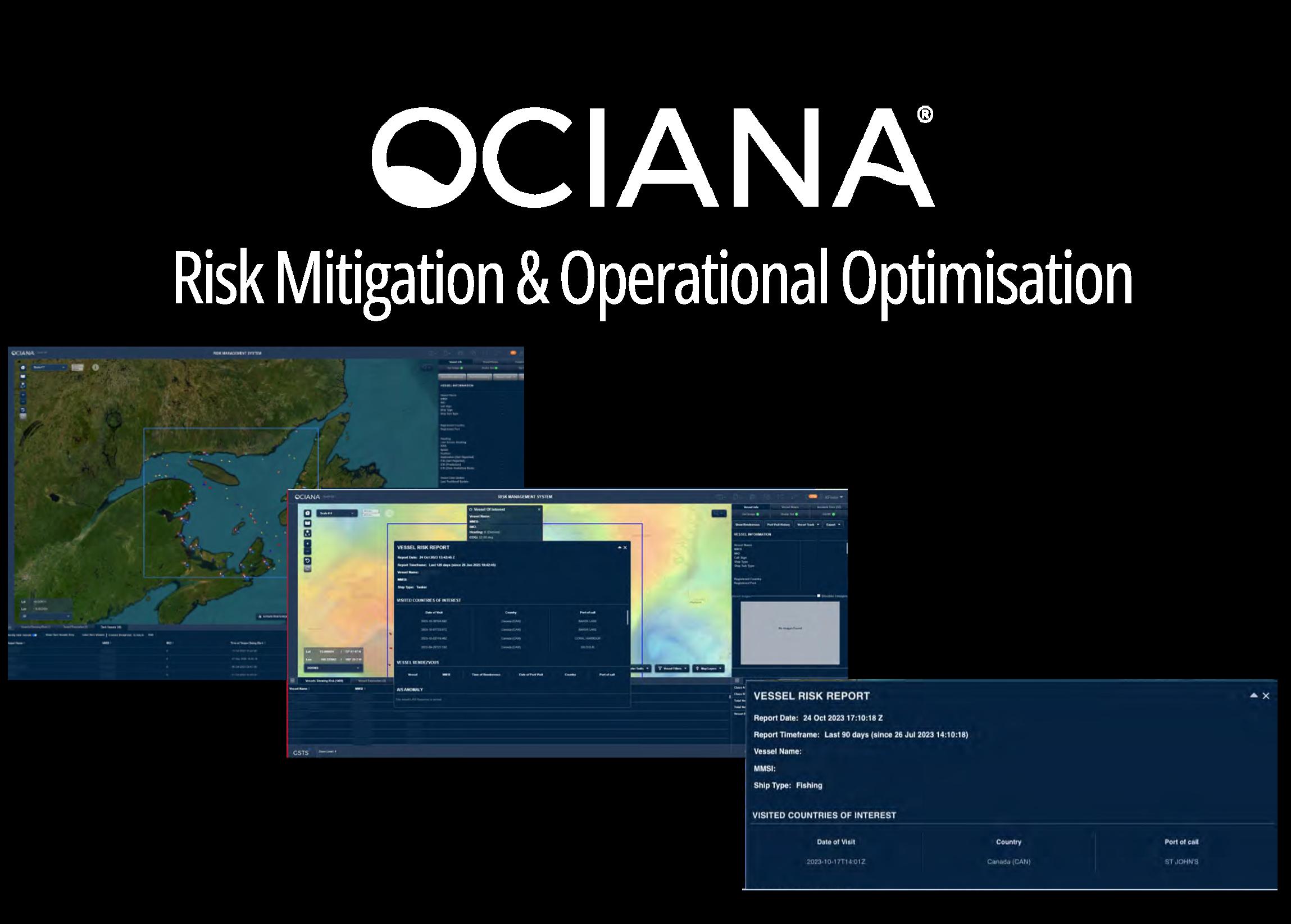


Sustainability strategies that work
Real-World solutions for port congestion
Exclusive networking opportunities
Access to gamechanging innovations






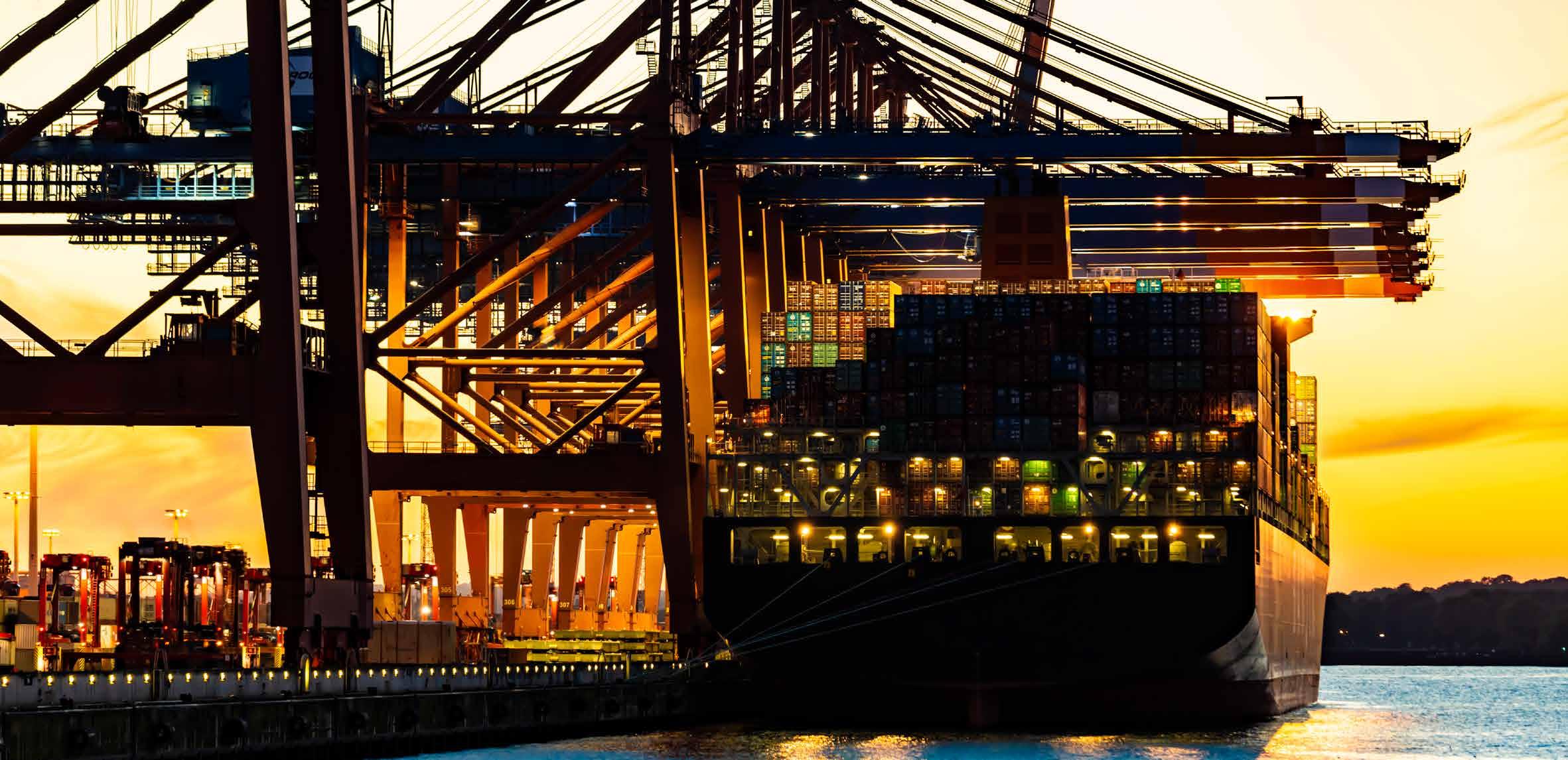
Welcome to the first journal of 2025! As we welcome the new year, we're excited to dive into the crucial topics of safety and security. These are fundamental themes for navigating the challenges in the maritime sector and for building a culture that makes safety a collective priority. This edition draws inspiration from our Maritime Safety Series virtual event at the end of last year. If you joined us then, you may recognise some of the contributors featured in these pages.
Drawing on those contributions, we’ve structured the journal into three key sections: Port Security, Technological Innovation, and Leadership and Change Management. Each section offers a unique perspective, providing practical strategies to help ensure we make safety a top priority in 2025.
As we look ahead, reflecting on the journey so far is equally important. In the middle section of this journal, our PTI reporters revisit 2024’s standout achievements in maritime digitalisation and sustainability, offering valuable insights as we move forward. We hope you’ll take a moment to reflect on these milestones with us and celebrate the progress made.
A special thanks goes to GSTS for sponsoring this edition and contributing invaluable insights into OCIANA®, a cutting-edge AI platform that enhances port security and operational efficiency. OCIANA® leverages real-time analytics,
vessel monitoring, geofencing, and anomaly detection to help ports mitigate risks, streamline processes, and optimise berth scheduling.
This edition also highlights sustainable innovations like the LifeLadder Thor® and Iridium Certus® GMDSS, which are shaping a safer and greener future for the maritime industry. These advancements not only address today’s pressing safety needs but also align with long-term sustainability goals.
In the second section, we turn our attention to Port Community Systems (PCSs) and their transformative potential. The IPCSA Foresight Workshop, held in Dubai and sponsored by Kale Logistics Solutions, brought together industry leaders to explore the future of PCSs and Single Windows, laying the groundwork for their evolution up to 2040.
Nico De Cauwer, Secretary General of IPCSA, takes this discussion further, examining how PCSs are revolutionising port operations and supply chain resilience. By enabling secure data exchanges and integrating risk management, PCSs enhance collaboration, visibility, and adaptability in the face of disruptions. Case studies from the Port of Los Angeles and PORTNET Morocco demonstrate how these systems improve efficiency, reduce emissions, and bolster security, all while underscoring the importance of standardisation for global interoperability.
Margherita Bruno, Editor

Our final section focuses on leadership and change management and their critical role in fostering a safety culture. Normagene Dmytriw, Ed.D., discusses how leaders can embed safety as a core value by demonstrating visible commitment, allocating resources, and fostering open communication. She also touches on the importance of infrastructure upgrades, preventive maintenance, and employee engagement in building resilience.
Dr Kate Blackford, Founder of Origami, addresses the human aspect of change—particularly the resistance that can arise when new technologies are introduced—stressing the importance of creating a culture of trust, empathy, and open communication to ensure employees feel empowered to embrace change.
Rounding out the discussion, Richard Steele, CEO of ICHCA, also takes a human-centred approach to safety leadership. By building trust, promoting shared ownership, and encouraging innovation, he illustrates how ports can integrate safety into their organisational culture, closing the gap between “work as imagined” and “work as done.”
As we embark on another year, we invite you to explore the tools, stories, and strategies within these pages. Together, we can navigate the challenges of 2025 and build a maritime industry that places safety and security at the core of everything we do.
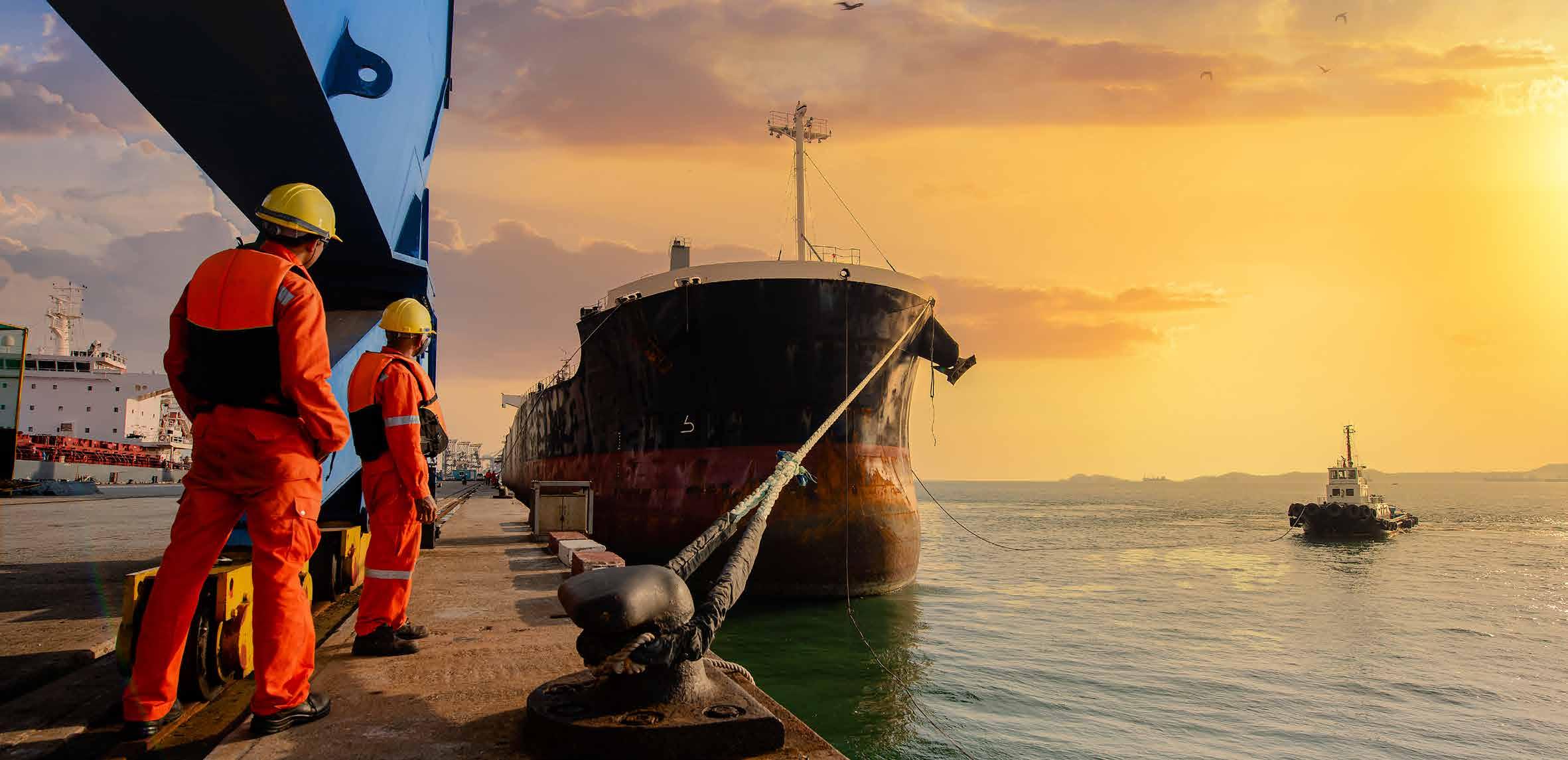
5.
OCIANA®: WORLD'S FIRST AI-POWERED COLLABORATIVE BERTH SCHEDULER GSTS
9.
OCIANA®: YOUR PORT'S PLATFORM FOR RISK MITIGATION AND OPERATIONAL OPTIMISATION GSTS
13.
INNOVATING HARBOUR SAFETY AND SUSTAINABILITY: PORT-SAFETY’S PRACTICAL SOLUTIONS
Kim Haaning, Managing Director, Port-Safety
17.
ENHANCING MARITIME SAFETY: THE LAUNCH OF IRIDIUM CERTUS GMDSS AND THE FUTURE OF SHIPBOARD COMMUNICATION
Wouter Deknopper, Vice President and General Manager, Maritime Line of Business, Iridium Communications Inc
21.
DECARBONISING MARITIME: LOOKING BACK ON 2024’S GREEN VOYAGE
Syed Rakin Rahman, Staff Reporter, Port Technology International
23.
MARITIME DIGITALISATION IN 2024 AND THE ROAD AHEAD
Dom Magli, Staff Reporter, Port Technology International
26.
IPCSA FORESIGHT WORKSHOP:
EXPLORING, ANTICIPATING AND PREPARING FOR THE FUTURE
Inga Morton, General Manager, IPCSA
31.
PORT COMMUNITY SYSTEMS TO SECURE PORT OPERATIONS AND CREATE SUPPLY CHAIN RESILIENCE
Nico De Cauwer, Secretary General, IPCSA
37.
ENHANCING SAFETY AND SECURITY AT PORTS: A COMPREHENSIVE APPROACH
Normagene Dmytriw, Ed. D., Risk Manager, Port Everglades
42.
SUCCESSFULLY MANAGING CHANGE WHEN INTRODUCING NEW TECHNOLOGY IN THE PORTS INDUSTRY - A HUMAN PERSPECTIVE
Dr Kate Blackford, Founder, Origami
46.
SAFETY LEADERSHIP IS ABOUT TAKING RISKS
Richard Steele, CEO, ICHCA
info@porttechnology.org @PortTechnology
www.porttechnology.org linkd.in/porttech

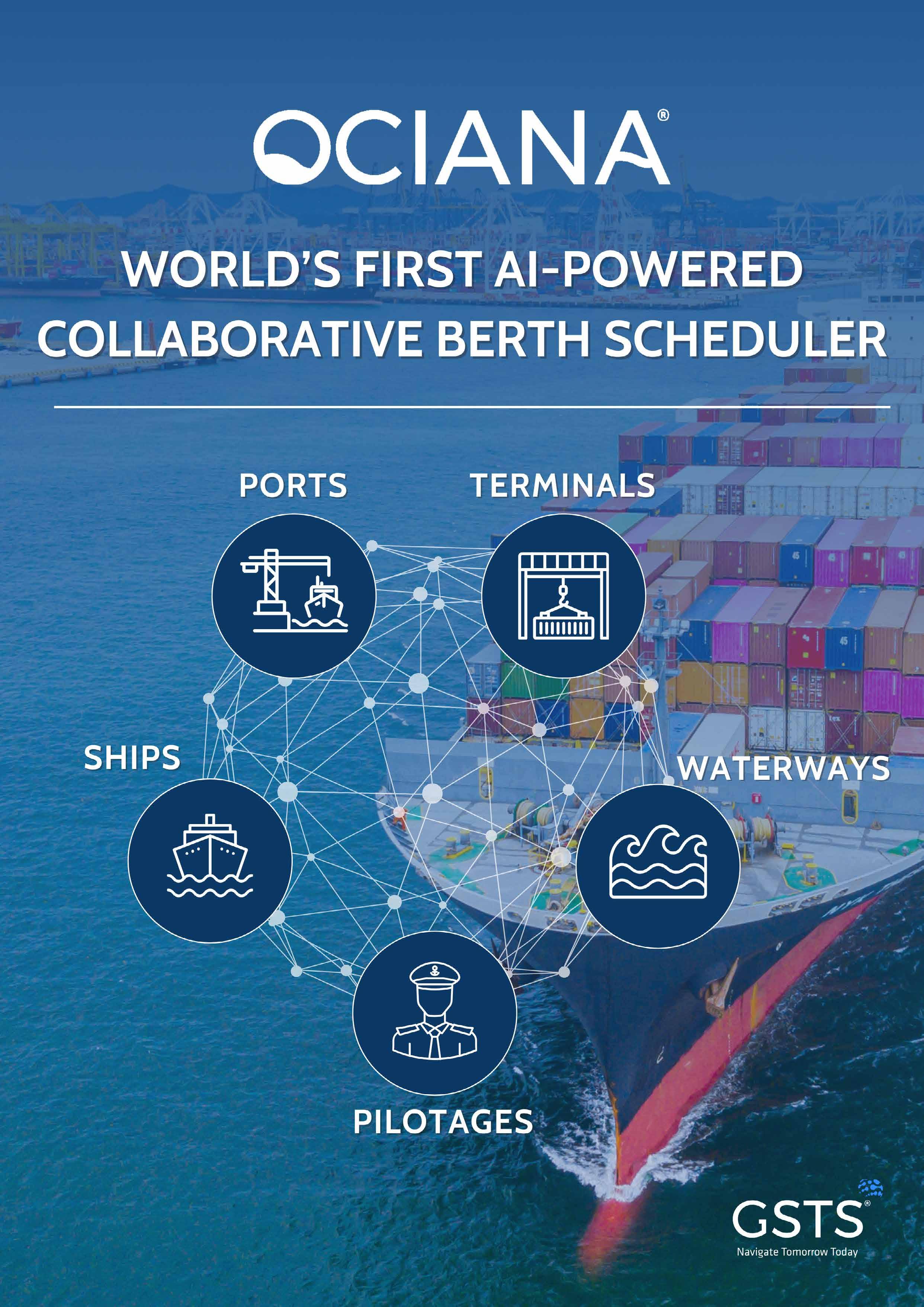
OCIANA’s Collaborative Berth Scheduler will connect ships, pilotage authorities, and ports to support Green Digital Shipping Corridors and environmental protection thus promoting the overall efficiency of the maritime supply chain.
In partnership with Canada Steamship Lines, Montreal Port Authority, Laurentian Pilotage Authority and Clear Seas, OCIANA’s latest capability will streamline vessel berthing through AI Predictive Analytics to support Just-in-Time Arrivals (JIT).





To allow ports, pilotage, and shipping lines to exchange near real-time data via a common platform, enabling digital planning and operational optimisation.
OCIANA® will be accessible to all maritime stakeholders globally. Benefits include:
• Real-time performance monitoring of global emissions information on vessel movements and vessel berthing delays in real-time
• Enhanced planning and coordination as it pertains to berthing windows
• Decision-making intelligence for dynamic environments
• Support for route optimisation
OCIANA® PLATFORM
OCIANA® incorporates the latest developments in Artificial Intelligence and Big Data analytics to improve maritime situational awareness and provide realtime decision-making intelligence.
OCIANA® will:
• Enable ships to optimise their steaming speed, thereby lowering fuel consumption, and reducing emissions Facilitate increased vessel productivity based on factors such as berth availability, vessel size and more accurate depth information
• Minimise time at anchorage and therefore reduce congestion in the port area
• Maximise berth occupancy Optimise human resource schedules through improved coordination
• Enhance intermodal coordination
• Reduce delays to maritime stakeholders
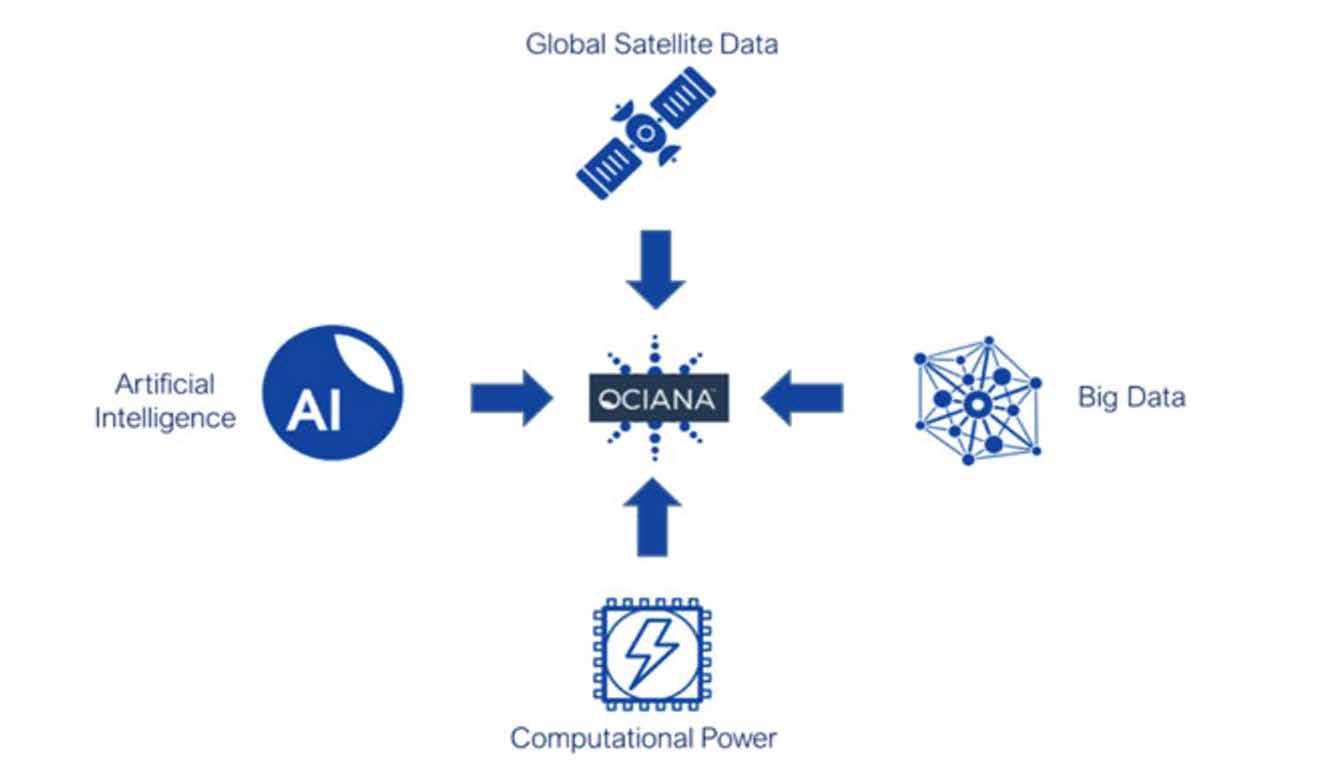
• To ingest a wide range of data sources including global AIS data, an array of satellite data, and weather data; OCIANA® also ingests IoT data
• Spatially and temporally correlates the data and employs AI algorithms
• Output from the AI/ML-trained models can be accessed through the online application or API
• An embedded communications channel enables multiple users to share information in real time Advanced chat and collaboration tools
RIGHT
Incoming VesselsLeveraging OCIANA's ETA Prediction and Intelligent Geofences Functionality
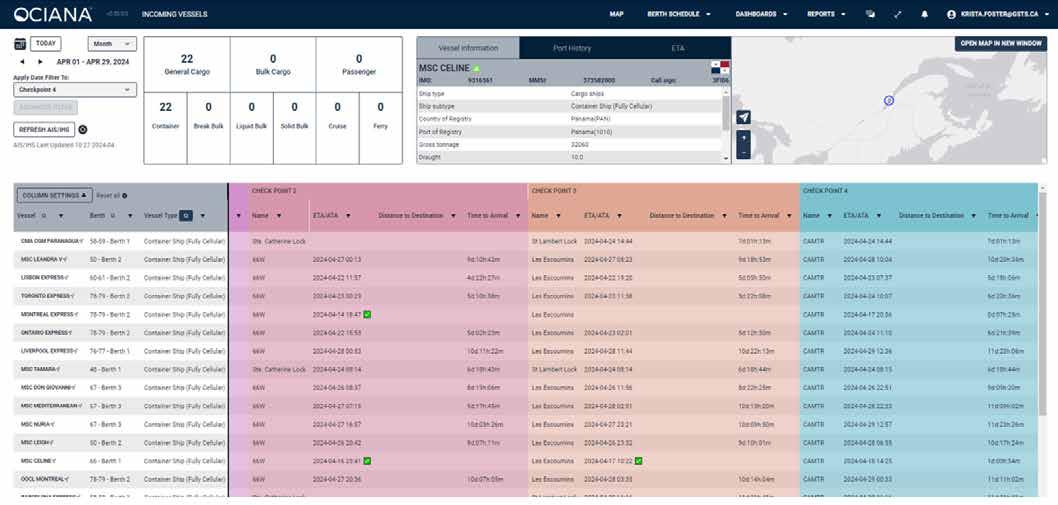
RIGHT In the Harbour –Leveraging OCIANA's Port Analytics

RIGHT
Schedule EntriesLeveraging OCIANA's Liner Service Automation
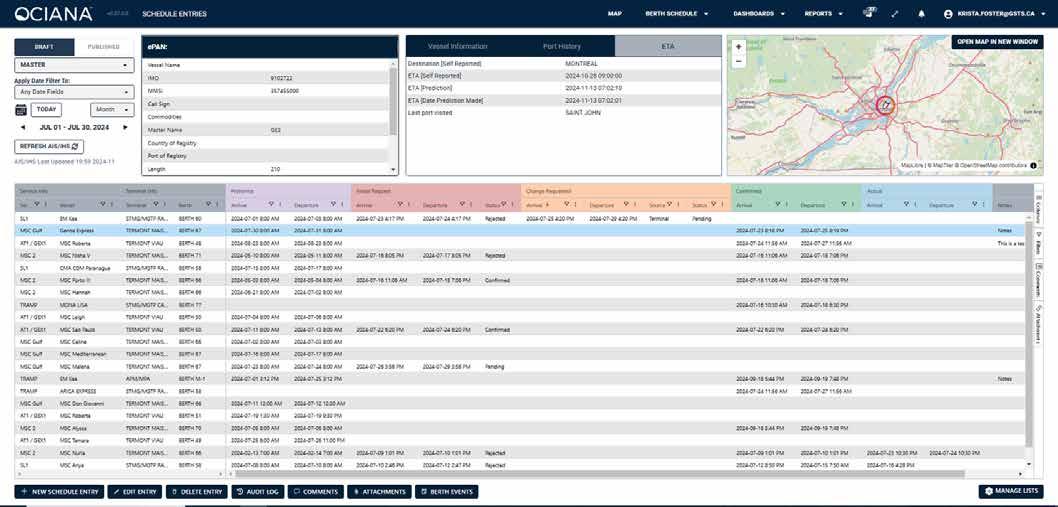
RIGHT Gantt ChartLeveraging OCIANA's Predictive Analytics

For more information, contact us at: sales@gsts.ca
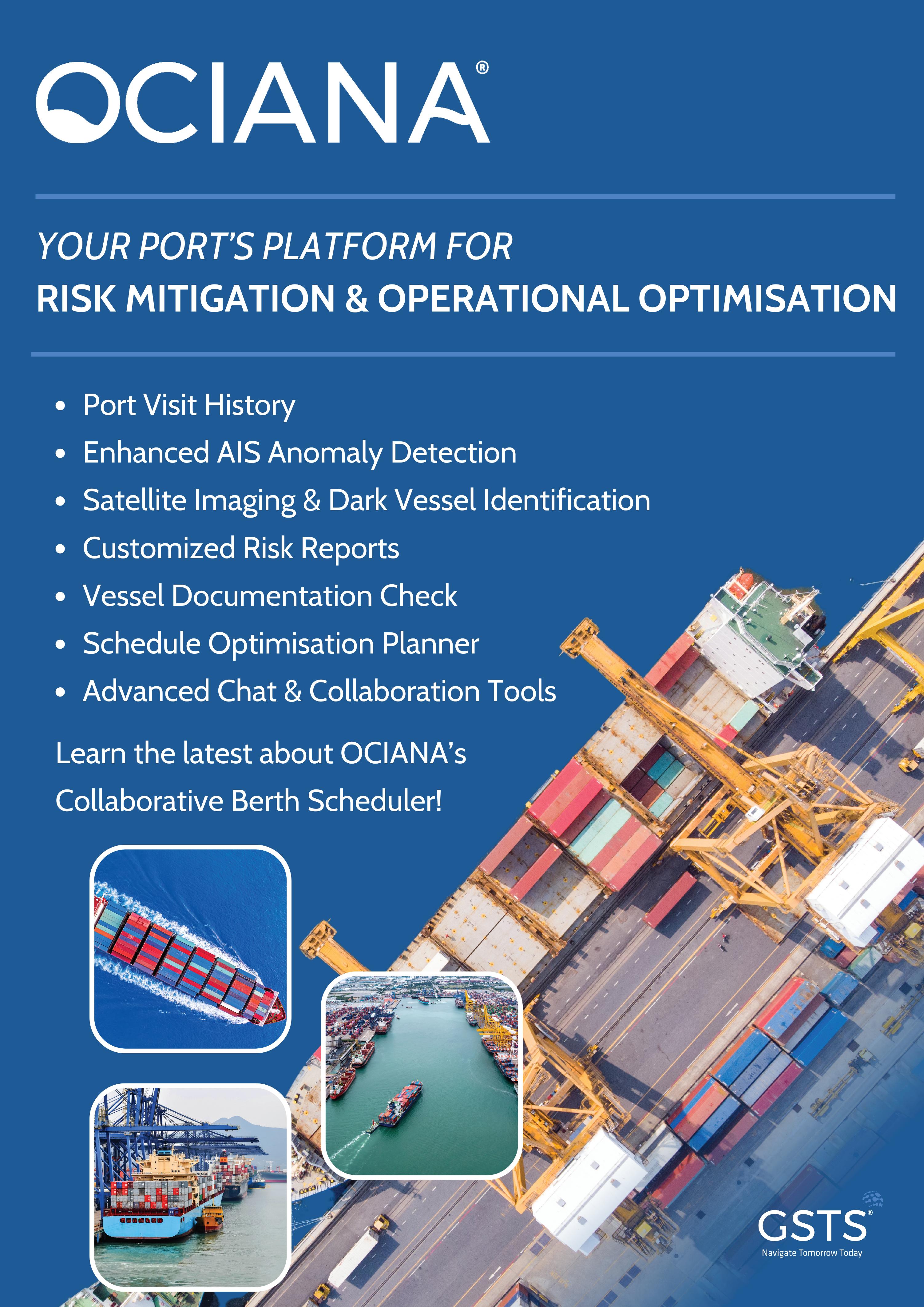
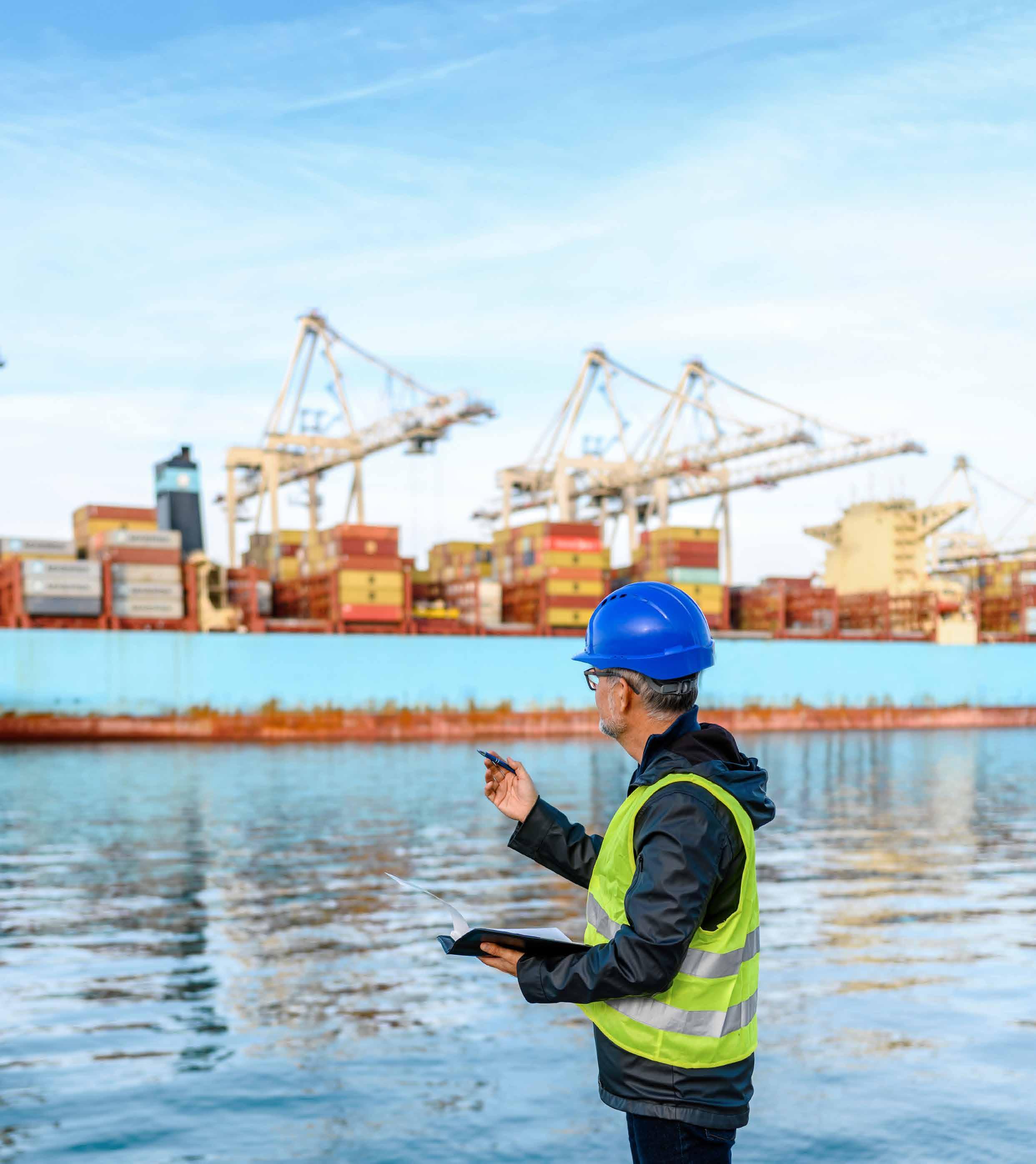
As global trade continues to expand, ports face increasing pressure to manage the vessels entering their facilities efficiently. Due to recent regulatory framework changes, there is a need for extended security at ports.
OCIANA® is a comprehensive solution for port management. The platform provides early risk detection to prioritise the monitoring of vessels of interest and thereby mitigate illegal activity. This proactive approach enables ports to allocate their resources more effectively to prevent potential security and safety risks. OCIANA® leverages real-time analytics thus facilitating decision-making and alignment with the global trend towards digitalised platforms.
OCIANA® constantly tracks worldwide vessel activities and leverages data analysis to empower users in making informed decisions. OCIANA's port visit history feature allows users to assess the potential risk associated with vessels arriving at the port. By examining a vessel's recent activity and its history of visiting different ports over the past two years, users gain insights into its frequency of visits and length of stay at all ports around the world. Additionally, users can set up geofences to receive notifications when a vessel has visited specific ports the user may flag, allowing for proactive risk assessment.
A vessel turning off its AIS, known as "going dark", can be a red flag for

potential illicit activities. OCIANA® addresses this challenge by offering enhanced AIS anomaly detection. Rather than flagging all vessels that temporarily disable their AIS, OCIANA® analyses individual vessels' historical behaviour and the regions it has visited. This approach reduces false alarms and focuses on vessels that genuinely exhibit abnormal behaviour.
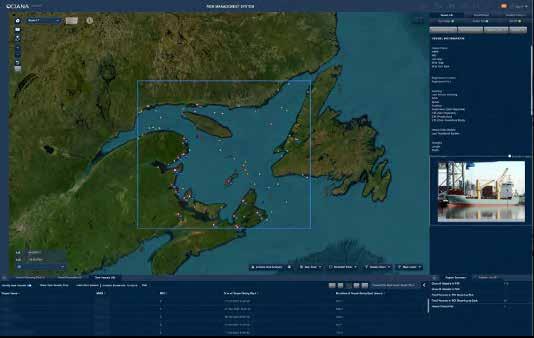
With the increasing availability of satellite imagery, it has become harder for vessels to conceal their positions. OCIANA® integrates truecolour and Synthetic Aperture Radar (SAR) imagery for ports, providing a comprehensive overhead view of the entire area. A machine learning


model is applied to identify vessels in these images, and their positions are cross-referenced with AIS data. This allows OCIANA® to flag dark vessels that are not reporting their positions despite being detected in the imagery, prompting further investigation.
OCIANA® goes a step further in enhancing port security by offering users the capability to generate a variety of custom risk reports. These reports can be based on countries of interest,


vessel rendezvous, AIS anomaly and other user-specific needs and preferences. The platform then compiles comprehensive risk reports in PDF format thus facilitating a valuable resource for informed decision-making and information sharing. These reports highlight vessels that have been flagged as risks and provide detailed explanations for each vessel, outlining the specific reasons and contributing factors behind the risk designation. This transparency in risk assessment empowers users to make strategic decisions and fosters efficient communication among stakeholders, ensuring that all stakeholders are on the same page regarding potential security and safety concerns.
OCIANA® serves as a collaborative platform, facilitating communication and information sharing among users from different organisations. It supports features like chat, data sharing, incident reporting, and notifications regarding vessels of interest. This capability is especially beneficial for collaboration between security agencies and ports. Using OCIANA®, all stakeholders can collaborate effectively by sharing vessel information, adding notes, and forwarding findings to relevant parties. This seamless cross-organisational cooperation ensures that critical information is disseminated promptly to the appropriate authorities when a concerning vessel is identified.
OCIANA® also streamlines communication between ships and ports. Vessel credentials can be uploaded into the platform, allowing ports to verify the status and validity of required documentation quickly. This, in turn, expedites the port monitoring
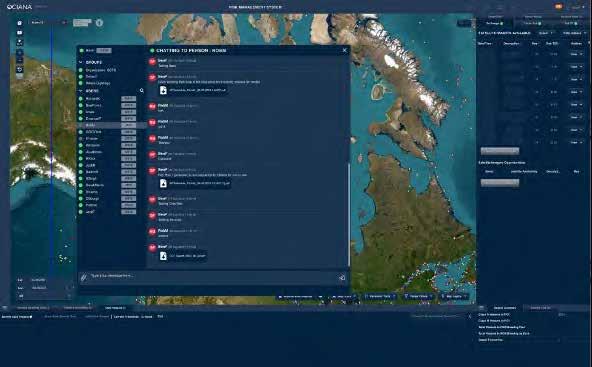
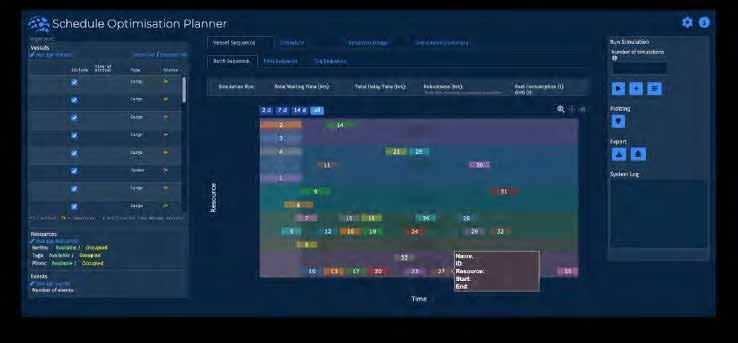
process and flags vessels with outdated or missing credentials which necessitates further investigation before entering the port.
In situations where a flagged vessel requires thorough inspection, it can strain port resources and disrupt operations. OCIANA's Schedule Optimisation Planner empowers port users to plan the sequence for incoming vessels when a berth is allocated for inspection.
This planning approach ensures continuous vessel throughput and minimises disruptions to port operations when searches are necessary.
In conclusion, OCIANA® offers a comprehensive suite of capabilities to enhance port safety and security. By enabling the identification of vessels in need of further investigation based on their activity, monitoring, and history, it aids in mitigating disruptions and risks to port operations.
GSTS is a global company that leverages AI to optimise operations, enhance decisionmaking, and manage risks across the maritime and logistics sectors. GSTS’ proprietary platform, OCIANA®, will provide the world’s first AI-powered Collaborative Berth Scheduler to facilitate digital collaboration and supply chain efficiency through reduced vessel emissions and fuel use.
For more information, contact us at: sales@gsts.ca



Kim Haaning, Managing Director, Port-Safety
As cities and ports evolve to accommodate growing populations and diverse activities, ensuring the safety of harbour users has become a top priority. Modern harbour zones serve multiple functions, from facilitating industrial operations to providing spaces for residential and recreational use. However, this diversity also increases risks, particularly when safety infrastructure is outdated. Traditional harbour equipment, such as ladders and handrails, is often prone to corrosion, damage, and poor visibility, undermining safety and efficiency.
Recognising these challenges, Port-Safety has emerged as a leader in developing practical, reliable, and sustainable safety solutions for harbours. With innovative products like LifeLadder Thor® and the Turtle Handhold Set, the company addresses the pressing needs of modern harbours while minimising maintenance costs and environmental impact. Port-Safety is setting a new standard for harbour safety worldwide by prioritising durability, visibility, and sustainability.
Harbours are dynamic environments where the intersection of industrial, public, and recreational activities creates unique safety challenges. Drowning accidents along harbour quays remain a significant global concern, particularly in areas where older infrastructure is still in use. As harbours are redeveloped into bustling, multi-use spaces,

the risks to professionals and the public grow exponentially.
Traditional safety ladders, typically made of steel, are a case in point. These ladders are prone to rust, require frequent maintenance, and often fail to provide adequate visibility during emergencies. Furthermore, they may not comply with modern safety standards, leaving harbours vulnerable to accidents and liability issues.
Port-Safety identified a critical need for solutions that are not only reliable but also easy to maintain and environmentally friendly. Their approach integrates cutting-edge materials and thoughtful design,
ensuring that harbours can meet the demands of today while preparing for the challenges of tomorrow.
Launched in April 2024, LifeLadder Thor® represents a significant advancement in harbour safety technology. As an updated version of Port-Safety’s original rescue ladder, LifeLadder Thor® addresses common issues with traditional ladders while enhancing safety and visibility under all conditions.

1. 24/7 Visibility: Integrated solar panels ensure the ladder remains visible day and night, even in low-light conditions. This feature is particularly valuable in emergencies, where visibility can be a matter of life and death.
2. Durable Design: Engineered to withstand impacts and compression, LifeLadder Thor® retains its functionality in the toughest environments, making it a dependable choice for busy harbours.
3. Non-Corrosive Materials: Unlike steel ladders, LifeLadder Thor® is made from materials
that do not rust, eliminating the need for frequent painting and significantly reducing maintenance costs.
4. Bright Yellow Colour: The ladder’s through-coloured yellow material ensures superior visibility compared to traditional orange ladders, enhancing its effectiveness as a safety tool.
By combining these features, LifeLadder Thor® offers a practical, low-maintenance solution for modern harbours. Its innovative design not only enhances safety but also aligns with sustainability goals, making it an ideal choice for forward-thinking ports.

In addition to rescue ladders, PortSafety has developed the Turtle Handhold Set, a robust solution designed to address recurring issues with traditional quay handrails. Developed in collaboration with ports, marinas and municipalities, this product reflects Port-Safety’s commitment to meeting the realworld needs of harbour users.
1. Built to Last: The handhold’s durable construction can withstand the weight of heavy machinery passing over it, ensuring its longevity even in high-traffic areas.
2. Preventing Misuse: Designed to prevent its use as a mooring point, the Turtle Handhold Set reduces the risk of damage and ensures that safety equipment remains functional.
3. Low Maintenance: With its ability to withstand harsh environmental conditions, the Turtle Handhold Set requires minimal upkeep, saving time and resources for harbour operators.
This product complements the LifeLadder Thor®, creating a comprehensive safety solution for harbours. Its bright colour and sturdy design ensure visibility and reliability, even in challenging conditions.
Port-Safety’s commitment to sustainability is evident in every aspect of its product design. Beyond improving safety, the company’s innovations aim to reduce environmental impact and contribute to global sustainability goals.
1. Lower Carbon Emissions: The LifeLadder Thor® achieves a 67 per cent reduction in cradle-togate CO2 emissions compared to traditional steel ladders. This significant reduction is made possible through the use of advanced materials and streamlined manufacturing processes.
2. Paint-Free Materials: By using through-coloured, non-corrosive materials, Port-Safety eliminates the need for painting, reducing resource consumption and harmful emissions.
3. Extended Lifespan: The durability of the LifeLadder
Thor® and Turtle Handhold Set means they require less frequent replacement, minimising waste and further reducing their environmental footprint.
These sustainability initiatives position Port-Safety as a leader in promoting greener, more efficient harbours. The company supports the maritime industry’s transition to eco-friendly practices by integrating environmental considerations into its product designs.
Harbours are critical to global economies, serving as hubs for trade, transportation, and urban development. Ensuring their safety and sustainability is essential for their continued success. PortSafety’s innovative products, including the LifeLadder Thor® and Turtle Handhold Set, are designed to address these dual priorities effectively.
By focusing on practicality, durability, and sustainability, PortSafety has created solutions that help harbours meet safety challenges without incurring unnecessary costs. Their products are easy to install, require minimal maintenance, and are built to withstand the tough conditions of maritime environments.
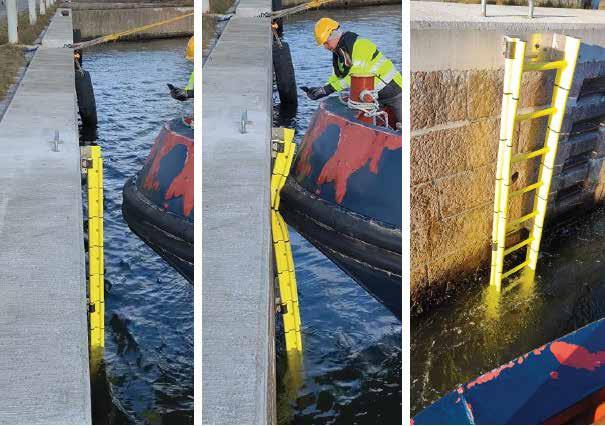
Port-Safety’s success lies in its collaborative approach. By working closely with industry stakeholders, including port authorities, marinas, and municipalities, the company continually refines its products to meet the evolving needs of modern harbours. This partnership-driven strategy ensures that Port-Safety’s solutions remain practical and effective.
With over 30 years of maritime experience spanning leadership roles at A.P. Moeller–Maersk, VIKING Life-Saving Equipment, and Germanischer Lloyd, Kim Haaning, Managing Director of Port-Safety, brings unparalleled expertise in maritime safety innovation. Holding an eMBA from IMD, Kim has dedicated the past decade to advancing sustainable safety solutions that save lives in marinas and along quay walls. He emphasises that safety is no longer a market differentiator but a fundamental standard. Drawing on insights from across the maritime industry, Kim's mission is to accelerate the adoption of safety innovations and reduce the risk of drowning worldwide.
Founded in 2017, Port-Safety has become a global leader in harbour safety solutions, serving 38 countries. The company specialises in developing durable, low-maintenance products tailored to the needs of city wharves, industrial ports, marinas, and other waterfront facilities.
Port-Safety’s mission is to enhance safety and sustainability in maritime environments. By providing innovative, practical solutions, the company aims to protect both people and the planet. Learn more about their groundbreaking products and vision at www.port-safety.com or contact the team at info@port-safety.com.



Wouter Deknopper, Vice President and General Manager, Maritime Line of Business, Iridium Communications Inc
As the maritime industry faces increasing challenges such as more extreme weather, growing trade, piracy and heightened safety concerns, the launch of Iridium Certus® GMDSS marks a significant evolution in maritime communications. This advanced system meets the requirements of the International Maritime Organization's (IMO) Global Maritime Distress and Safety System (GMDSS) and promises to revolutionise the way vessels remain connected across the globe, where other geostationary satellite systems fall short.
This paper explores the key features of Iridium Certus GMDSS, its operational advantages, and its potential impact on maritime safety and security.
In 2020, Iridium broke the GMDSS monopoly, launching the first truly global GMDSS service. Iridium® GMDSS provides a GMDSS solution including SafetyVoice, Maritime Safety Information (MSI), Long Range Identification Tracking (LRIT), and Ship Security Alert System (SSAS) in a single terminal. Launched in December 2024, Iridium Certus GMDSS extends the core maritime safety and security capabilities of its widely adopted predecessor by providing data and voice services that complement broadband satellite services onboard. The consolidation of maritime safety, security and critical communications equipment reduces onboard complexity

for fleet managers and crew, whilst providing a reduction in operational costs compared to other GMDSS providers. Iridium GMDSS does not require an intermediary Accounting Authority, further reducing operational costs for fleets. The fees for Accounting Authority roaming charges may be very high, potentially exceeding the vessel’s monthly broadband costs.
The “all in one” combination of maritime safety, security and ship’s business (data and voice services back-up) is compelling for modern vessels and fleet operators. Inclement weather (rain, snow, fog, etc.) easily impacts and reduces Ku and Ka-band connectivity used by broadband satellite services, whereas L-band is largely unaffected. This is a primary reason why L-band has been chosen for safety—it is dependable even in adverse weather conditions. A less obvious restriction of Ku and Ka-band services is when
a vessel is alongside or close to port. Obstructions such as cranes and warehouses can block the antenna’s view to geosynchronous VSAT satellites. Iridium Certus GMDSS is designed to meet the unique operational needs of today’s modern maritime fleet.
The Lars Thrane LT-4200S is the first Marine Equipment Directive (MED) approved terminal to provide Iridium Certus GMDSS, with several key manufacturers following throughout 2025. It is the first Iridium Certus GMDSS terminal combining distress alert, SafetyVoice, and MSI with other regulatory services such as SSAS and LRIT. Unlike non-Iridium GMDSS systems that are limited by geographical constraints, Iridium Certus GMDSS offers truly global coverage, ensuring that no matter
where a vessel is located, it can maintain voice communications with Rescue Coordination Centres (RCCs) and other maritime safety agencies.
With a significant maritime satellite communications heritage behind it, the LT-4200S is designed to meet and exceed the safety and security requirements of a SOLAS class vessel.
• True Global Coverage: Provides comprehensive coverage across all oceans, ensuring continuous communication even in the most isolated regions.
• Distress Alert and Safety Voice: These critical services allow crew members to instantly communicate distress signals, automatically transmitting the vessel's position to RCCs and enabling voice communication for swift, detailed reporting.
Maritime Safety Information (MSI): This feature informs vessels of real-time weather conditions and maritime hazards, ensuring safer navigation.
• High-Quality Voice and IP Data: The system delivers high-quality voice calling and IP data services, supporting a vessel's operational and safety communications needs and providing a companion for broadband services.
• Extended Distance: The LT-4200S supports up to 150m between the control unit and antenna.
The LT-4200S terminal, which includes the control unit, handset, and antenna, is compact and easy to install. The system's advanced GNSS/GPS receiver supports vessel tracking, which is crucial for managing the location of vessels in distress. Installation of the LT4200S is simple, therefore reducing the cost and time required for deployment.
OUTLOOK: EXPANDING THE ROLE OF IRIDIUM CERTUS IN HYBRID COMMUNICATION SYSTEMS
As the maritime industry increasingly adopts automation and digitalisation, having a
flexible, secure, reliable and truly global communication system, which Iridium Certus provides, will be indispensable for maintaining safety standards, improving operational workflows, and supporting the broader goals of the industry's digital transformation. The digitalisation of the “floatingoffice” is dependent upon reliable communications, regardless of where a vessel is moored or sailing.
Iridium Certus GMDSS service will play a pivotal role in the future of maritime communication, particularly as fleets move toward hybrid communication systems that combine disparate satellite and broadband technologies. Maritime operations have become increasingly data-driven, and the ability to manage safety and operational communications through one unified system is a crucial step forward. Despite the proliferation of Ku and Ka-band Next generation LEO services, such as Starlink, Project Kuiper and classic VSAT for maritime,
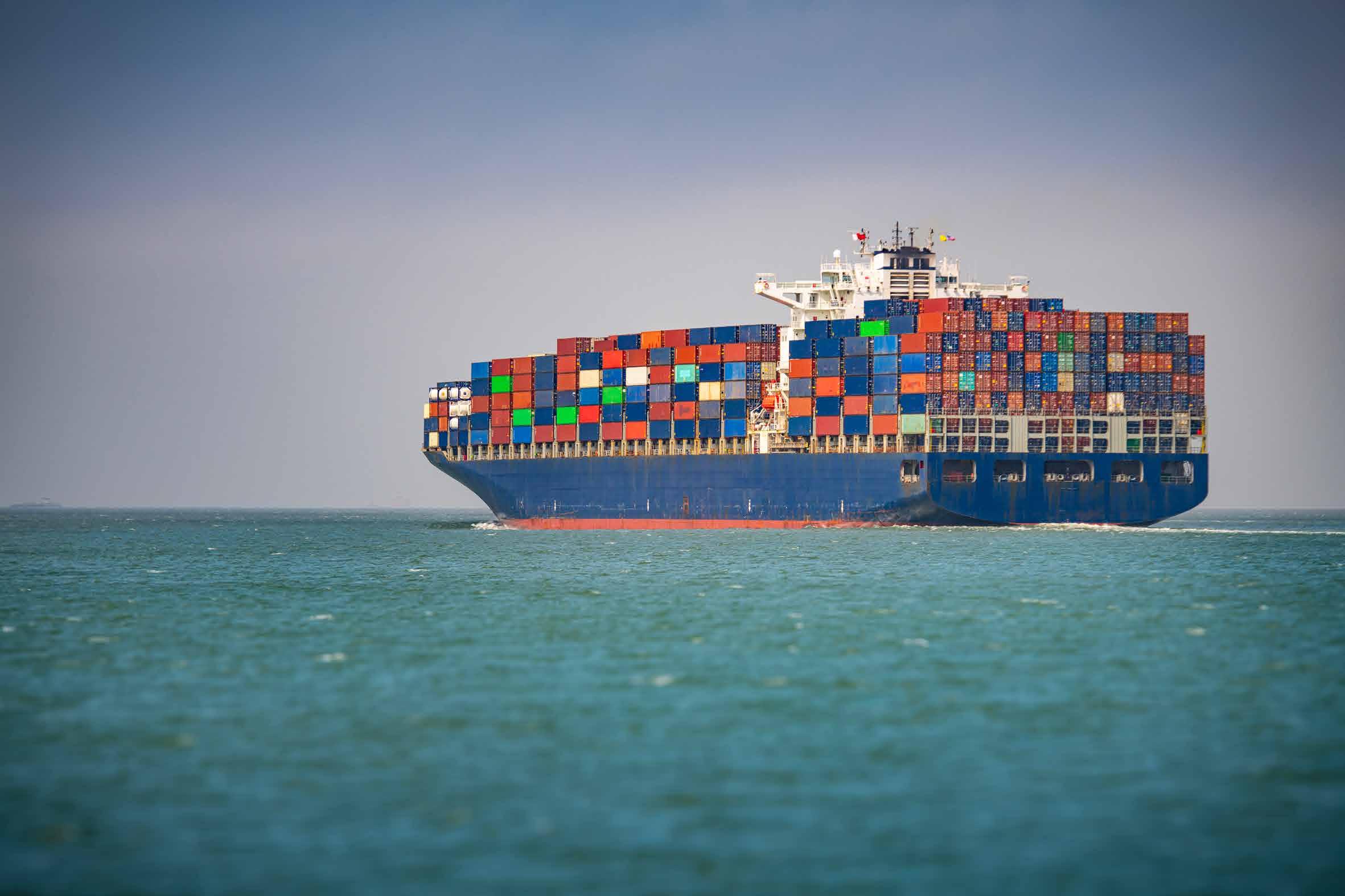
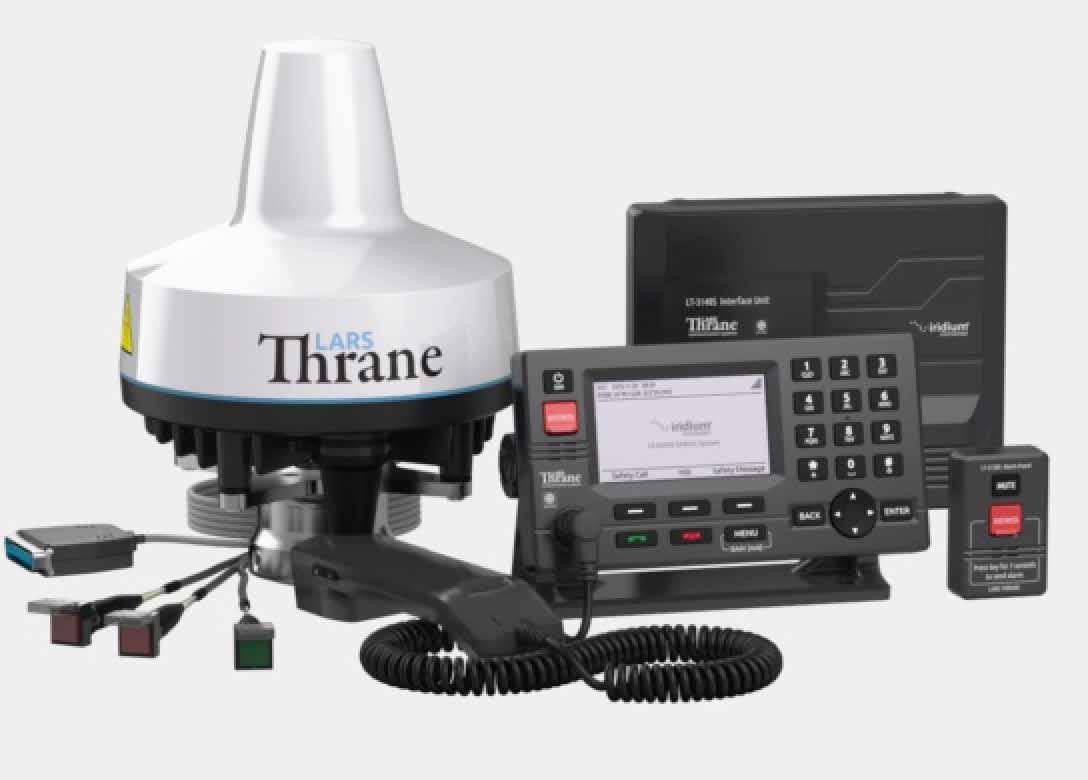
maintaining a diverse multi-band hybrid communications strategy should be at the forefront of a fleet manager’s mind.
Additional leading equipment manufacturers, including Cobham Satcom, Intellian, and Thales, will launch compatible terminals throughout 2025, broadening the adoption of Iridium Certus GMDSS service, making it the standard for critical maritime communication systems. As the maritime industry continues to evolve, Iridium's commitment to innovation and safety means that the Iridium Certus GMDSS service will remain at the forefront of maritime communication technology.
Iridium Certus GMDSS represents a significant advancement in the maritime industry's efforts to improve safety, efficiency, and communication reliability. With its global coverage, cost-efficiency, and integration of critical safety services, it is poised to become the standard for satellite communication in maritime operations. As the first Iridium Certus GMDSS terminal to market, the Lars Thrane LT-4200S offers unmatched performance in remote and challenging environments, providing vessel owners and operators with the tools to help ensure the safety of their vessels and crews worldwide.
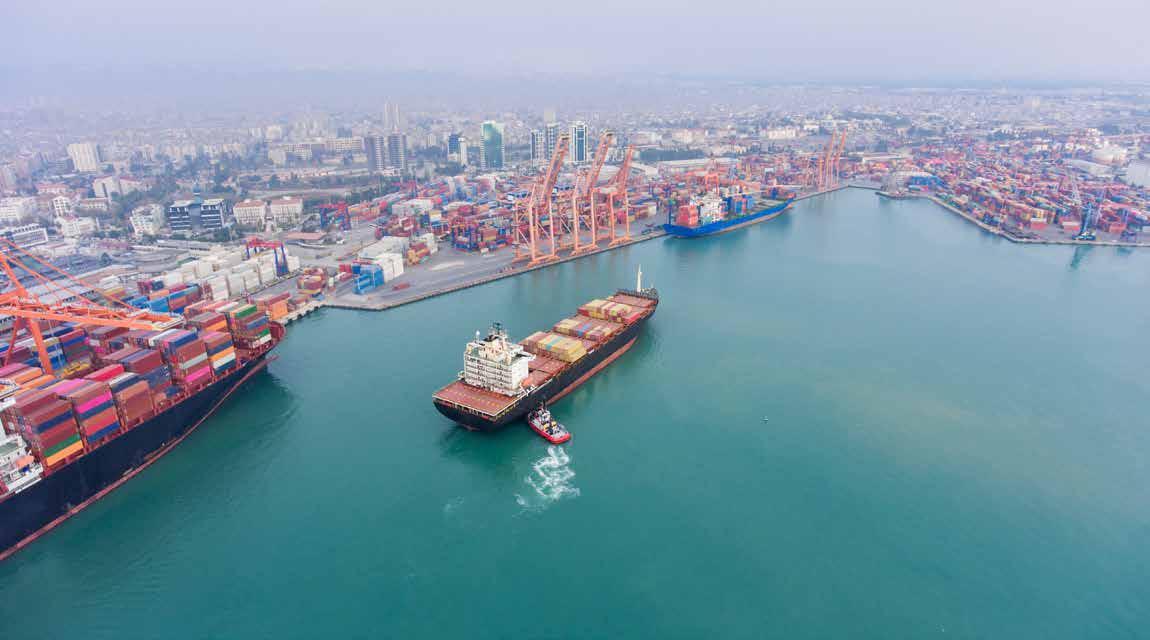
Wouter Deknopper is the Vice President & General Manager of the Maritime line of business at Iridium Communications Inc., the only satellite communications company that offers truly global voice and data coverage. In this role, he is responsible for bringing new services and products to market in alignment with Iridium’s business objectives while attuned to the needs of the end-users in maritime industries.
Iridium Communications Inc. is the only mobile voice and data satellite communications network that spans the entire globe. Iridium enables connections between people, organisations, and assets to and from anywhere, in real time. Together with its ecosystem of partner companies, Iridium delivers an innovative and rich portfolio of reliable solutions for markets that require truly global communications.
For more information visit www.iridium.com


As we leave 2024 behind, the shipping world finds itself at a decisive juncture in its evergreen pursuit of decarbonisation. Spurred by the uptick in governmental regulations, innovation and collaboration, maritime players worldwide have taken tremendous strides in reducing their carbon footprint. Most notably, in this watershed year, we have seen decarbonisation targets codified into international law. Yet, while a concerted push towards achieving net zero shows signs of promise, the route ahead presents many waves we must be ready to navigate. In this annual roundup, we revisit the most transformative developments and challenges that shaped 2024, while examining their lasting impact going forward.
We begin with delving into perhaps the most material development for maritime decarbonisation; the International Maritime Organization’s (IMO) revised GHG strategy. The strategy came into manifest in 2024, with Member States and stakeholders beginning to transition from conceptual frameworks to concrete legal plans aimed at achieving EU-imposed targets of cutting GHG emissions by 5 per cent by 20230 compared to 1990, levels and achieving netzero emissions by 20250.
In March 2024, the IMO proposed a draft framework to achieve net zero, marking a significant step towards legally implementing global measures to reduce emissions, known as mid-term GHG reduction measures. These measures support the objectives of the revised 2023
Syed Rakin Rahman, Staff Reporter, Port Technology International
IMO Strategy on the reduction of GHG Emissions from ships.
The draft outline illustration of a potential framework proposed amendments to the International Convention for the Prevention of Pollution from Ships (MARPOL), particularly Annex VI, to introduce:
• A Global Marine Fuel Standard: Designed to progressively reduce the GHG intensity of marine fuels.
A Global Emissions Pricing Mechanism: Aimed at incentivising the maritime industry's transition to net-zero emissions.
The IMO made notable advancements in finalising the framework throughout the rest of the year, with the most significant milestone reached during the 82nd session of the Marine Environment Protection Committee (MEPC 82) in the fall of 2024. At this session, Member states created a draft legal language to guide discussions on potential mid-term measures, which include a goal-based marine fuel standard and the emissions pricing mechanism.
The draft also incorporates discussions about potential revisions to the International Convention for the Prevention of Pollution from ships (MARPOL, Annex VI). If ratified, these modifications would enshrine such proposed measures into international law. IMO Members are expected to endorse the revisions prior to their formal adoption in October 2025. During the event, the possibility of establishing an IMO GHG Intensity Registry was discussed, along with
an IMO fund/facility to aid in implementing the technical and economic components of GHG reduction initiatives.
Moving on, from 1 January 2024, the developments of the EU ETS marked another unprecedented step in decarbonisation. As part of the broader “Fit for 55” initiative, the EU ETS was extended to include the shipping sector from 1 January. This expansion now applies to cargo and passenger vessels above 5,000 gross tonnage (GT) operating within European Economic Area (EEA) ports, including nonEuropean flagged ships.
The EU ETS is a cap-and-trade system requiring ship operators to monitor, report, and verify annual emissions, surrendering European Union Allowances (EUAs) or facing penalties for non-compliance. In February 2024, the European Commission released a detailed list of over 2,000 shipping companies covered under the scheme, based on data from the Thetis MRV platform.
The EU ETS' impact can be seen in two ways: in the short term, we may see a mild fuel tax for shippers accompanied by operational adjustments such as slower vessel speeds to curb fuel consumption; the long-term goal, more notably, is the adoption of efficiency-enhancing technologies and sustainable practices.
Port Technology International, reporter, Dom Magli stated: “While legal pitfalls remain regarding the ambiguity of the legislative process, which has caused some Member States to lag behind in implementing the directive, its expansion
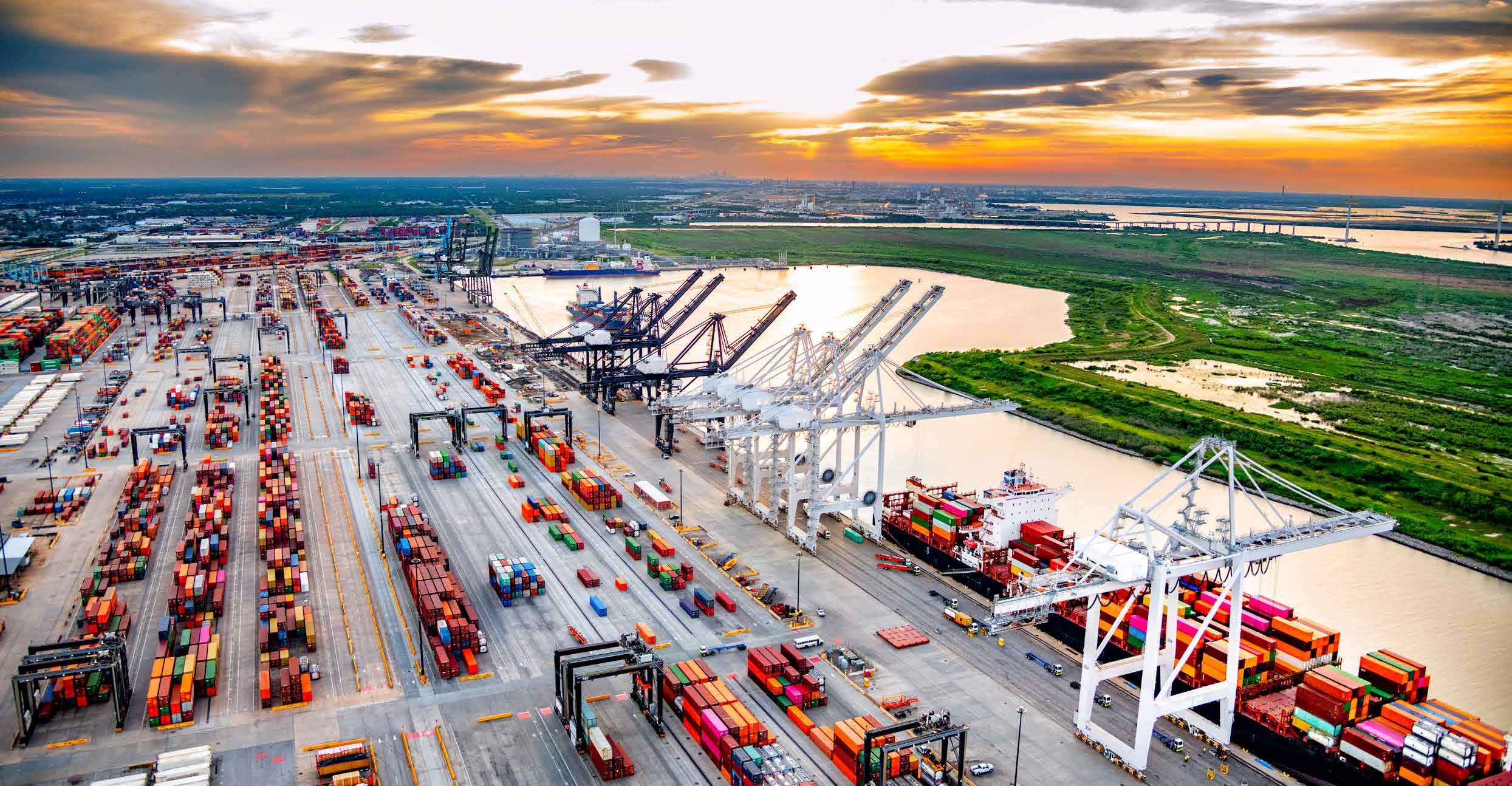
into shipping presents an opportunity above all else.”
Moreover, shipping has seen its greatest transition to alternative fuels in 2024. Green ammonia and hydrogen gained significant traction among shippers and ports, with the launch of several notable pilot projects and feasibility studies assessing their potential as zero-carbon fuel options. In October 2024 alone, hydrogen advancements included the Port of Gothenburg launching a refuelling station for heavy traffic, the Port of Newcastle securing agreements for hydrogen-focused infrastructure in its Clean Energy Precinct, and the Port of Oakland receiving a $2.5 million grant for hydrogen initiatives.
With the rise of methanol as another prominent alternative fuel, investments have been made industry-wide which is testament to the fuels practicality for accommodating existing infrastructure.
Significant investment includes Hapag-Lloyd securing a deal to transport 250,000 tonnes annually, COSCO Shipping partnering on production, and Maersk signing a biomethanol offtake agreement . Additionally, AD Ports Group and partners signed a Memorandum of Understanding (MoU) to plan a green methanol storage and export facility.
Additionally, an update by Lloyd’s Register’s Zero Carbon Fuel Monitor (ZCFM) earlier this year reported on an improved readiness of ships adopting alternative fuels like those mentioned above. More specifically, 31 vessels are reportedly ammonia-capable, and over 400 are
ammonia-ready, while 315 vessels can use methanol. The report, however, emphasized the need to address critical challenges, including improving safety protocols, enhancing crew training, and increasing investment to overcome uncertainties surrounding fuel availability, infrastructure development, and regulatory frameworks.
Accompanying this rise in green ships, 2024 chartered new territory through introducing a plethora of sustainable corridors. Global green shipping corridors expanded by 40 per cent in 2024, advancing through feasibility studies, roadmaps, and commercial trials, according to the Shipping Telegraph.
Notable milestones included the launch of the Green North Sea Shipping Corridor linking the UK to Amsterdam, the publication of the first progress report for the Los Angeles-Long Beach-Shanghai corridor, and the formalisation of the Singapore-Australia Green and Digital Shipping Corridor through an MoU. These developments underscore significant strides in decarbonising the maritime sector.
Some other notable key developments in 2024 include the Port of Long Beach and Shenzhen Port Group signing a Memorandum to advance clean technologies and sustainable infrastructure in ocean trade. CMA CGM Group and SUEZ partnered to supply 100,000 tonnes of biomethane annually by 2030 for gaspowered ships, invest €100 million ($105.4 million) in biomethane production, and conduct joint biofuel research. Additionally, Hapag-Lloyd entered a transformative
agreement with Ankeri Solutions to collaborate on fleet decarbonisation initiatives. These developments reflect a growing commitment to sustainable maritime practices.
Commenting on the year’s developments, Port Technology International, Managing Director, Tracy Catlin, remarked: “With the advancement in global GHG strategies, the EU’s expanded remit for its ETS Directive, and the industry’s concerted push for alternative fuels coupled with the launches of greens corridors worldwide, 2024 has been a year of transformation for shipping.”
“Despite the progress, regulatory gaps, safety issues, and infrastructure limitations yet persist as obstacles in the road to net-zero. 2025 will be crucial for translating commitments and legislation into material action and results.”


As we bid farewell to 2024, we explore how digitalisation has evolved within the maritime sector over the past year and uncover what this progress means for 2025.
Digitalisation ranges from automating manual processes to employing data analytics to make educated judgments. Its goal is to minimise volatility by enabling more accurate and precise communication between workers and clients, resulting in greater awareness of how to handle and maximise capacity.
According to Richard Clayton, Chief Correspondent at Lloyd's List, the advent of Global Maritime Distress and Safety Services and Inmarsat C in the late 1990s and early 2000s marked an early inflection point in maritime digitalisation. Fast forward 20 years, and it has become one of the most important components of increasing the industry's operating efficiency and safety.
Let's look at the most notable digitalisation trends for 2024.
5G is the fifth generation of wireless communication technology and is the latest network infrastructure available. Its importance in maritime stems from its capacity to increase communication, hasten the introduction of autonomous vessels, and create remote operation.
In July, Latvian mobile innovator and telecom operator LMT collaborated with Latvian port technical services provider, LVR Fleet, to complete a successful 5G
Dom Magli, Staff Reporter, Port Technology International
marine connection concept demonstration in the Port of Riga, demonstrating fully operational 5G network connectivity from shore to ship, among ships, and between ships and drones.
That same month, Rijeka Gateway, a joint venture between APM Terminals (APMT) and ENNA Group, deployed a nextgeneration private 5G campus network with the goal of providing 20 times the data throughput and significantly lower latency than LTE networks.
Singtel and Ericsson recently announced a partnership to deploy 5G advanced connectivity solutions at Singapore's Tuas Port, with Automated Guided Vehicles (AGVs) being upgraded to 5G to improve real-time shipment tracking and further streamline crane operations, allowing for seamless cargo transportation from berth to ship and vice versa.
Ng Tian Chong, CEO Singtel Singapore, highlighted the benefits of 5G, stating that its "high speeds and low latency help to improve real-time communication and data transfer which enables highly efficient port operations."
An electronic bill of lading (eBL) is a digital counterpart of the traditional paper bill of lading used in shipping. It serves as a contract between the shipper and the carrier, detailing the products to be carried as well as the shipment terms. It also serves as proof of receipt and a document of ownership for the items.
By decreasing paper-based administration, this digitalised form of bill of lading can improve efficiency, increase security, save expenses, and promote environmental sustainability.
In June, South Korean shipping line, Hyundai Merchant Marine (HMM), formed a strategic partnership with CargoX to include eBL technologies into the company's digital service platform, aiming to modernise and optimise eBL procedures.
One month later, the Global Legal Entity Identifier Foundation (GLEIF) and WaveBL collaborated to digitally change eBLs and associated trade paperwork. Through this agreement, the firms wanted to increase operational efficiency, security, and reduce the cost of regulatory compliance.
Omer Guy, Legal Advisor of Digital Container Shipping Association, spoke on how eBLs combat the traditional methods of trade documentation: "In the digital world, a bill of lading cannot be lost. If you need to amend it, for example, you can just surrender it by digitally transferring it to the carrier who can reissue it in a matter of seconds. This eliminates the possibility of losing the bill of lading and makes the process faster and more efficient."
Artificial intelligence (AI) undoubtedly took centre stage worldwide, transforming countless applications and industries— and the maritime sector was no exception. AI primarily seeks to offer systems capable

of doing activities and solving issues that would normally need human intelligence.
In July, French shipping carrier CMA CGM partnered with one of the world's largest corporations, Google, to speed the integration of AI across the company's worldwide operations
That same month, Bearing AI, a US operation solutions provider, introduced enhanced capabilities to its AI Deployment Planner tailored specifically for tramp shipping companies. The company reported that the updated Deployment Planner uses powerful AI models to analyse large amounts of historical and real-time data.
Four months later, in November, Prodevelop announced the conclusion of the EIFFEL project, a collaborative research and development effort focused on enhancing climate change adaptation strategies through the application of AI and data from the Global Earth Observation System of Systems (GEOSS).
Commenting on the revolutionary power of AI, Port Technology International Reporter, Rakin Rahman, said: "Artificial Intelligence is continuously progressing forward in maritime. Companies now more than ever are seeing the value that it brings to the industry, as AI clearly is helping improve profitability, safety, and efficiency."
Cybersecurity in the maritime industry plays a critical role in safeguarding ships, infrastructure, and businesses from
cyber-attacks. With over 90 per cent of global commodities transported by sea, according to the European Maritime Safety Agency (EMSA), a successful cyberattack could disrupt a significant portion of the world's supply chain— making robust cyber defences more vital than ever.
A significant step forward in bolstering cybersecurity occurred last year in February, when the Biden Administration announced that it would issue an Executive Order to boost port cybersecurity in the United States. The move was set to improve the security of US ports, as well as various other steps to increase maritime cybersecurity. The US government indicated plans to invest more than $20 billion in new port infrastructure over the next five years, including cranes manufactured in the US, which authorities believe would pose less of a cybersecurity and counterintelligence risk.
Later in the summer, the International Maritime Cyber Security Organisation (IMCSO) was launched to enhance cybersecurity risk assessment across the maritime industry . The IMCSO introduced a security consultant certification system and a professional registration to help marine companies select qualified individuals with confidence. Additionally, the IMCSO will review report outputs to ensure consistency, which will then be stored in a central database and made accessible to authorities and third parties requiring a vessel's risk status.
Another key development in port cybersecurity came from the Seaports Trade Organisation (Brancheorganisatie Zeehavens, BOZ), the Ministry of Infrastructure & Water Management, and the National Coordinator for Counterterrorism and Security (NCTV), who collaborated to define a strategy aimed at safeguarding cybersecurity at ports . As part of this strategy, the FERM Foundation—already operational at the ports of Rotterdam and Moerdijk— will be transformed into a national cybersecurity platform for Dutch seaports, unified under BOZ.
Reflecting on last year's advancements in digitalisation, Margherita Bruno, Editor at Port Technology International, highlighted the growth of maritime digitalisation and shared her perspective on its future: "The maritime industry has historically been slower to adopt digital technologies, but there has been a noticeable shift in recent years. Many shipping carriers are now working closely with tech companies to improve the industry's efficiency, reliability, and safety. With 2024 marking a significant year for digitalisation development, there is optimism for continued progress in 2025.”



Inga Morton, General Manager, IPCSA

The push of the present, the pull of the future, the weight of history— what does it all mean for the future of data exchange in global trade and, specifically, for Port Community Systems and Single Windows?
Members of the International Port Community Systems Association (IPCSA) from diverse regions and various external experts actively engaged in comprehensive and insightful dialogues during the inaugural session of a series of three regional workshops. These workshops are part of an ambitious Foresight initiative.
The IPCSA's Foresight exercise is dedicated to exploring the future of Port Community Systems and Single Windows, with a forwardlooking approach extending to the year 2040. This collaborative effort aims to evaluate potential future scenarios and establish a framework and pathway that will guide its members and their organisations in the years to come.

The first two-day workshop, held in Dubai, was sponsored by IPCSA member Kale Logistics Solutions (Kale). The focus was on exploring the dynamics of change, discovering issues and understanding high-impact uncertainties.
Introducing the discussions, facilitator Will Sambrook of Akenham, told delegates: “We

cannot predict the future, but we can explore, anticipate and prepare. We certainly can’t predict the future of PCS and SW. Instead, we have to think about what futures might exist, and then we can think about what role PCS operators might play in those scenarios.”
Group discussions were based on the ‘Futures Triangle’:
• The push of the present—what trends are currently impacting our industry environment, what is pushing change forward, and what is the nature and pace of change?
• The pull of the future (horizon scanning)—what novel developments and signals of changes are we seeing, what seems to be slowing down or stopping, as well as starting or increasing, what do we know about the visions and aspirations of powerful actors, what matters at the margin of current thinking should we not miss?

• The weight of history—what is holding us back from changing, and are there any deep structures resisting change, such as prevailing cultural norms and values?
Delegates were challenged to be active participants, willing to share and ask questions, challenge each other and also challenge themselves by being open to new and different perspectives.
Factors raised by the discussions included climate change and the environment, the green economy, access to resources, political shifts, nationalism, protectionism, fragmentation, zero trust, equitable access to technology, demographics, e-commerce, cryptocurrency, AI and cyber threats.
Vineet Malhotra, Co-Founder and Director, said: “Kale shares a unified vision with IPCSA in transforming the global maritime industry through Port Community Systems and cutting-edge digital solutions. Our collaboration with IPCSA, spanning over five years, has allowed us to bring a unique blend of innovation and automation that drives global maritime trade. By supporting the first Foresight event in Dubai, we aim to amplify
the industry’s collective voice and fortify its role in advancing global trade harmonisation. This initiative is critical to shaping a future where streamlined, efficient trade becomes the standard across the industry.”
The Foresight project is exactly what the industry needs at this crucial juncture. With the rapid pace of digitalisation and the urgent need for decarbonisation, the project brings together key stakeholders who are dedicated to these critical causes, including trade harmonisation and simplification. In an era marked by geopolitical tensions, supply chain disruptions and the rise of AI, Foresight will not only set a new benchmark for IPCSA members but will also serve as a beacon for other industry stakeholders, showcasing a commitment to meeting both current and future industry needs.”
Without the Foresight project, there would be a significant gap in leadership within the industry, said Malhotra. “The absence of this initiative could hinder the progress of essential conversations and innovations needed to address the challenges. The industry would miss a critical opportunity to unite stakeholders around a common vision and drive meaningful change.”
Reflecting on the workshop, Mona Swoboda, Program Manager of the Inter-American Committee on Ports (CIP), Organization of American States (OAS) said:
“The First IPCSA Foresight Group Workshop provided important insights on long-term trends, challenges and opportunities for PCS implementation and operation, with special emphasis on change management, climate resilience, policy and legislation, as well as governance and labour. The diverse profiles, both professionally and regionally, of attendees resulted in a rich pool of knowledge and issues were assessed from several diverse angles which led to a more integrated analysis of PCS trends and challenges. The next IPCSA Foresight Group Workshop will certainly allow for more in-depth discussions and the formulation of guidelines and recommendations for national port authorities, maritime authorities, ports, and terminal operations.”
Uwe Liebschner, IPCSA’s Foresight Lead said: “The aim of IPCSA’s Foresight exercise is to consider the possibilities and establish where we see the issues for the future, bring together IPCSA members from all the regions to be involved and integrated in

the discussions, and increase communication and personal connections between members. At the end of the exercise, we will establish guidance and recommendations at a very high level, around mitigation and potential solutions. We can’t prepare for 100 per cent of potential issues but we can have a broad framework in place to be prepared for future challenges.”
Rommel Edwards, Manager, Digital Innovation and Development, at Barbados Port Inc., said: “The workshop facilitator was excellent. He pushed us outside of our comfort zones and areas of expertise to be able to prepare for possible future eventualities in a meaningful and logical fashion. Each carefully planned exercise was built on previously learned concepts. The next Foresight meeting should continue on this trajectory of building on what was done before.”
Even though the Port Community System and Maritime Single Window concepts have a large information technology (IT) component to them, the main issues affecting them lie outside the realm of IT, Edwards emphasised. He highlighted three major issues affecting these systems.
“First, legislation: very often, the technology is way ahead of the legislation. In Barbados, for example, digitalisation efforts are well underway, but there were pieces of legislation that only recognised paper-based manifests, Bills of Lading, penand-ink signatures and rubber stamps. Second, governance: again, due to leaps and bounds in the tech, the task of governing the ethical use of the tech is a challenge. Third, cybersecurity: global events pre and post-Covid have clearly demonstrated that the maritime industry is a soft target for cybercriminals. The protection of Single Windows adds another level of complexity to the task of protecting stakeholders. The community is as strong as its weakest link. A threat actor simply needs to breach the weakest member of the community and then engage in ‘lateral movement’ towards the intended and more secure target. This would be an easier route than attacking the intended target directly.”
“Changes in weather patterns are adversely affecting many aspects of the maritime sector. For example, storms are becoming more intense. Barbados and other countries in the southern Caribbean experienced
Hurricane Beryl. Barbados was preparing for a tropical storm, but in 24 hours, Beryl developed into a Category 5 hurricane, one of the fastest developments on record. None of the affected countries were prepared for a Category 5; they were all preparing for a tropical storm.
“Finally, cryptocurrency—once thought to be a fad and temporary, it appears to be here to stay. This has implications for how we assign value to services and commodities as well as for the way we trade. It is anyone’s guess as to whether the maritime sector will transition to crypto as the new norm.”
Foresight exercises help because they are a process of separating oneself from short-term issues, short-term forecasting and short-term thinking, said Will Sambrook: “Foresight is a process of looking ahead and looking for plausible, critical issues that could significantly impact the industry and our businesses.
“For example, one issue we discussed was how trade movements and the goods themselves will be paid for in the future. Will it be traditional forms of money, predominantly linked to the dollar? Or will we see many more digital currency exchanges being

used, maybe linked to a number of alliances rather than to the dollar?
“We don’t know which of these will play out, but we can start to think about what we can do to prepare for both scenarios. So, if one starts to become more likely than the other, we are at least partly prepared for it.
Sambrook added: “The ideas being shared at the Dubai workshop were excellent, as was the listening and challenging. What was interesting to see was the experiences of people from different countries and regions of the world. One thing people said was refreshing was that technology wasn’t the only issue on the table. We saw the impact of demographics, geography, economics, global alliances and ruptures. One issue was how end products might not dominate global trade in the future. It might be digital blueprints that allow goods to be 3D printed at their point of destination.”
Javier Gallardo, Chairman of IPCSA, said: “The Foresight exercise is thinking about 2040, which is not a huge amount of time away— thinking about things that might became mainstream influencers
by the time we get there. The Dubai Foresight workshop discussions considered technology, globalisation vs isolation, and what sort of things are happening on the margins that we need to start paying attention to.
Javier Gallardo highlighted as an association, we believe we have a commitment to our members to assist them by providing valuable information that enables them to navigate the future of Port Community Systems. While IPCSA’s objectives within this initiative extend beyond digitalisation, it is important to note that the changes will manifest in many ways, impacting not just digital transformation but also the way business is conducted and the relationships between individuals and entities.
“Thanks are due to Kale Logistics Solutions for sponsoring this very successful event. We now look forward to the second Foresight workshop, which will take place in Morocco, sponsored by IPCSA member PORTNET, on 21-22 May 2025. At this second workshop, the focus will move on to building scenarios and understanding implications.”
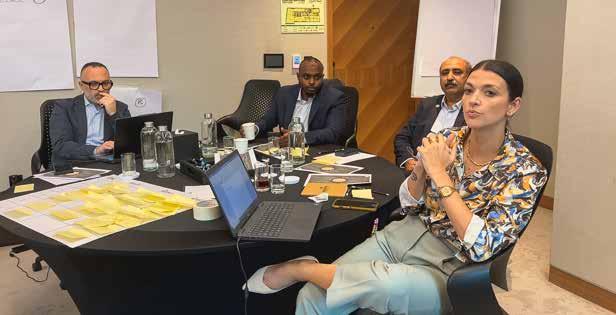
Inga Morton is General Manager of the International Port Community Systems Association and Member of the ICC Legal Reform Advisory board. A specialist in European Union and international law, she provides administrative support and expertise relating to policy makers.
Inga Mortona has extensive knowledge and experience across legislative, finance, data protection, competition law and strategic planning issues, having worked at a high level in both governmental and commercial sectors.
IPCSA is an international association of Sea and Air Port Community System operators, sea and air port authorities and Single Window operators that is recognised across the globe for providing advice and guidance on the electronic exchange of information across borders and throughout the whole supply chain.
IPCSA focuses on supporting and facilitating systems and innovations for Port Community System members and users, and promoting the use of international data standards in sea and air ports, at border crossings and via Single Window systems around the world. IPCSA is a recognised NGO with consultative status at UNECOSOC and IMO.
For more information, please contact Inga Morton, General Manager, IPCSA, inga.morton@ipcsa.international


Nico De Cauwer, Secretary General, IPCSA

The International Port Community Systems Association (IPCSA) has initiated a vital discussion about the role of Port Community Systems (PCSs) in enhancing the security of port operations and bolstering supply chain resilience. In this exploration, we draw on insights from industry experts who emphasise the strategic importance of PCSs in the modern maritime landscape.
When we talk about supply chains in general these days, two words constantly pop up: sustainability and resiliency. Both are used so often today that people tend to forget the
exact definitions, as well as what is meant by them. While I won’t attempt to restate their definitions, it’s safe to say few of us can recall their original definition in a concise phrase. Of course, context usually provides clarity, but this is merely a warm appeal not to forget the original meaning of the words.
When we focus on the port environment, and on supply chains more generally—after all, ports, both coastal and inland, are crucial physical hubs in the movement of cargo from origin to destination— we can agree that supply chain resilience refers to the ability of supply chains to anticipate, prepare for, respond to, and recover from unexpected disruptions. This must

apply to all actors in the chain so that the resilience is effective. The COVID-19 pandemic underscored this need, offering valuable insights into the context and success factors required to enhance resiliency in the supply chain landscape.
Reflecting on the recent IPCSA Foresight Dubai workshop discussion on supply chain resilience as a crucial factor for the industry’s future (pages 26-30, this publication), Mona Swoboda, Program Manager of the InterAmerican Committee on Ports (CIP) at the Organization of American States (OAS), highlighted: “PCSs
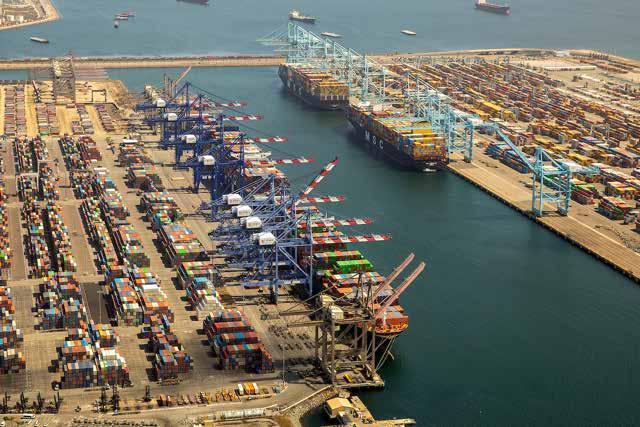
have the potential to transform and reform (port) ‘business as usual’. However, there are several trends that could impact PCS implementation and operation in the years to come. Cyber-resilience is an important issue that must be addressed by PCS operators, port authorities and all members of the port community. Here, international guidelines and best practices will be critical in bolstering robust cybersecurity measures. New trade routes and supply chain logistics are another topic of relevance for PCSs, as they will significantly shape how trade, and related data, flow Lastly, legislation and political buy-in are key in facilitating the change management aspect of PCSs and will certainly continue to influence the future of PCS implementation and operation.”
Swoboda noted that climate resilience was raised as a focus area at the Dubai workshop, as it impacts PCS implementation and operation in many ways: “For example, Port Community Systems reduce time and costs, especially as they relate to the duration of cargo vessels in port. This can significantly lower emissions—in some instances, PCSs have contributed to a more than 80 per cent reduction of CO2 emissions in a port. When PCSs are managed as resilient systems,
they also positively contribute to the continuity of a port and its community business, which can have a direct positive impact on economic resilience.”
Supply chain resilience is at the top of the agenda for everyone involved in transport and logistics today. Ensuring the uninterrupted flow of goods, along with the indispensable electronic services needed to accompany these cargo flows, remains critical—even in the face of challenges such as natural disasters, economic shifts or global pandemics. When we dive a bit deeper into the key aspects regarding supply chain resilience and the above context, we can identify five principal categories—not with the intention to declare a universal theoretical truth, but as guiding principles:
1. Flexibility: being able to adapt to changes and reconfigure your supply chain according to the needs.
2. Redundancy: having systems and/or suppliers in place to ensure continuity.
3. Visibility: real-time monitoring with transparency across your supply chain to identify and address issues.
4. Collaboration: working together as a community to coordinate responses to disruptions.
5. Risk management: identifying potential risks and develop a risk mitigation strategy for them.
The development of the PCS at the Port of Los Angeles serves as a practical example of enhancing supply chain resilience.
In 2017, Los Angeles introduced the only PCS data platform of its kind in North America, aiming to enhance operational efficiency for the port and its supply chain stakeholders. This cloud-based information portal was designed to help cargo owners deliver their goods to market with greater predictability and timeliness. Launched in collaboration with Wabtec Corporation, the Port of Los Angeles’ digital platform transformed its operations by extending cargo flow visibility to an impressive three-week outlook. Port Optimizer has continually evolved over the years, incorporating new features based on user feedback and adapting to changing supply chain conditions. In summer 2024, the port received a $8 million grant from the California Governor’s Office of Business and Economic Development (GO-Biz). This award was the largest of five GO-Biz grants, totalling $27 million, aimed at enhancing data and supply chain functionality and supporting system interoperability across five California ports.
“This GO-Biz funding will help the Port of Los Angeles to accelerate our proven technology, the Port Optimizer, to further improve efficiency, lower impacts on our communities and make us more competitive,” said Port of Los Angeles Executive Director Gene Seroka. “We’re grateful to the state of California and GO-Biz for being the first state to step up with policy and funding to enhance supply chain digitalisation.”
In today's dynamic environment, supply chain visibility is no longer the goal of digitisation. Instead, it serves as a crucial tool that empowers port users to make informed decisions and manage the complex movement of cargo from origin to destination.
In the last week of 2024, the Port of Los Angeles handled approximately 129,000 inbound containers—a 73 per cent increase compared to the same week in 2023, according to estimates from the Port Optimizer. The benefits make the PCS vital to the resilience of the port community and its sustainability. By enhancing agility, transparency and efficiency, the PCS ensures that the port can adapt to changing conditions and demands.
Another great example has been proven by PORTNET Morocco, whose CEO Youssef Ahouzi, also IPCSA Regional Representative for Africa, said: “Since its inception, the PORTNET community in Morocco has been committed to facilitating trade by optimising logistics and streamlining procedures both within and beyond port operations. By bringing together
all stakeholders on a unified digital platform, PORTNET has enhanced transparency, minimised administrative complexities and expedited clearance processes. This integrated approach drives operational efficiency, fortifies supply chain resilience and guarantees the seamless and uninterrupted movement of goods.”
Amid increasing global trade challenges, PORTNET’s focus on innovation and digital transformation underscores the vital role of Port Community Systems in enabling secure, efficient and resilient port ecosystems: “This continued commitment not only safeguards port activities but also boosts competitiveness and fosters sustainable trade growth,” Ahouzi said.
“A PCS serves as a unified digital platform for all stakeholders, including government agencies, shipping companies, terminal operators and freight forwarders, to interact seamlessly,” remarked Vineet Malhotra, Co-Founder and Director of Kale Logistics Solutions and IPCSA regional representative for Asia Pacific.
“This collaboration ensures that everyone has access to the same real-time data and insights, making it easier to address security concerns and operational challenges quickly. By breaking down silos, PCSs foster a culture of cooperation and shared responsibility in securing ports,” he added. “Additionally, PCSs simplify the implementation of mandates and compliance requirements by embedding them into systems such as the International Maritime Organization’s Maritime Single Window and FIATA’s e-Freight Bill of Lading (e-FBL). This integration ensures regulatory adherence while reducing administrative burdens. In terms of supply chain resilience, this collaborative approach helps ensure that resources such as trucks, cranes and dock workers are deployed where they are most needed, reducing congestion and minimising delays during periods of high demand.”
The attacks on shipping in the Red Sea led to a major overhaul of cargo movements in 2024 and it is believed that cargo owners are paying at least $500 extra per container as cargo is moved via
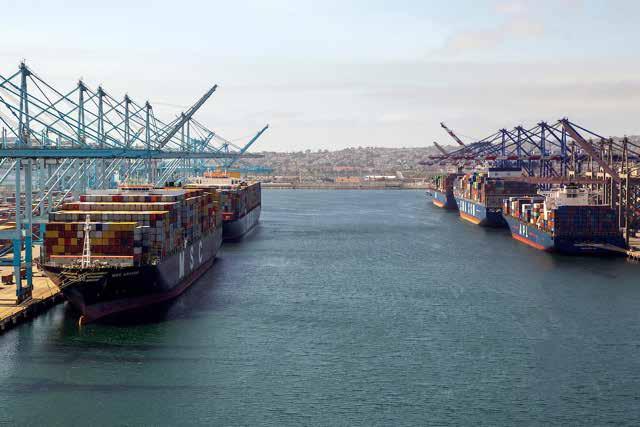



alternative routes. “With a PCS in place, there will be end-to-end visibility and zero blind spots so that the security personnel can be prepared with a response mechanism,” added Malhotra. “On the other hand, in terms of a blockade, an alternative route can be seamlessly identified, thereby making the process simple. Such a response system is valuable during public emergencies such as the COVID-19 lockdowns.”
An AI-powered PCS could also play a pivotal role in ensuring maritime cargo security, according to Malhotra: “Enhanced risk management, automated surveillance, anomaly detection and real-time monitoring of ports and shipyards, and identifying suspicious activities are some of the security applications of AI in the maritime space. PCSs enriched with AI can seamlessly evaluate historical data, shipment details and external factors to predict high-risk consignments and provide immediate alerts for potential risks, such as tampered containers or unauthorised access.”
Industry expert Dr Phanthian Zuesongdham, Hamburg Port Authority’s Head of Division Port Process Solution and IPCSA regional representative for Europe, perfectly summarised the significant role that PCSs play in advancing sustainability: “PCS functions facilitate transparent and sovereign
data exchange and communication among various parties. This allows each stakeholder and actor in the logistics chain to tailor PCS services to their specific needs and organisation. As a neutral and trusted entity in each port, serving as a node in the transport chain, a PCS helps connect the dots within the network.”
“Each PCS in every port has expert knowledge of local procedures, processes and key players in the ecosystem. This enables global shipping lines and logistics companies to collaborate with PCSs to obtain essential information, which is then used to enhance the resilience of their supply chain network,” she said.
Finally, the use of standardised data exchanges is crucial for empowering digital transformation across all supply chain players, as Zuesongdham emphasised: “IPCSA fosters and supports the implementation of international standards through engagement in different standard bodies and discussion. Additionally, in a trusted cooperation between PCS operators and port operators, the ecosystem partners may facilitate the exchange of irregularities. This enables the activation of contingency plans, ensuring business continuity and maintaining service levels.”
Vast and dynamic geopolitical factors, along with unpredictable
Vineet Malhotra, Co-Founder and Director, Kale Logistics Solutions Ahouzi Youssef CEO, PORTNET Dr. Phanthian Zuesongdham, Head of Division Port Process Solution, Hamburg Port Authority
weather conditions, can dramatically disrupt supply chains: “The implementation of a PCS fosters a collaborative environment, ensuring that all parties involved in port operations are aligned and informed, thereby enhancing overall security and resilience,” added Zuesongdham.
“In many countries, PCSs are considered critical infrastructure. Consequently, the technical and organisational security requirements are very high. Collaborating with PCSs helps supply chain actors verify and enhance their own security measures.
“By integrating advanced digital platforms, PCSs reduce the risk of human error and unauthorised access, thereby strengthening port security.”
Over the 14 years since IPCSA’s inception, PCS technology and implementation have evolved significantly. However, the core strategy and pivotal roles of PCSs in enabling and optimising supply chains are still there today, and more relevant and real than ever.
Nico De Cauwer has been SecretaryGeneral of IPCSA since 1 May 2023.
He is a member of the Industry Advisory Board at the Digital Standards Initiative (DSI) of the International Chamber of Commerce (ICC), a participating Expert member of the UN/CEFACT Transport and Logistics Domain, and resides in the IMO Expert Group on Data Harmonisation (EGDH) of the International Maritime Organisation (IMO).
Nico is also a member of the Data Collaboration Committee at IAPH, the International Association of Ports and Harbors.
As Business Architect Port Community Solutions at the Port of Antwerp-Bruges, he has 30 years of experience in the port and maritime sector, and he is involved in a wide variety of digitalisation and innovation projects.

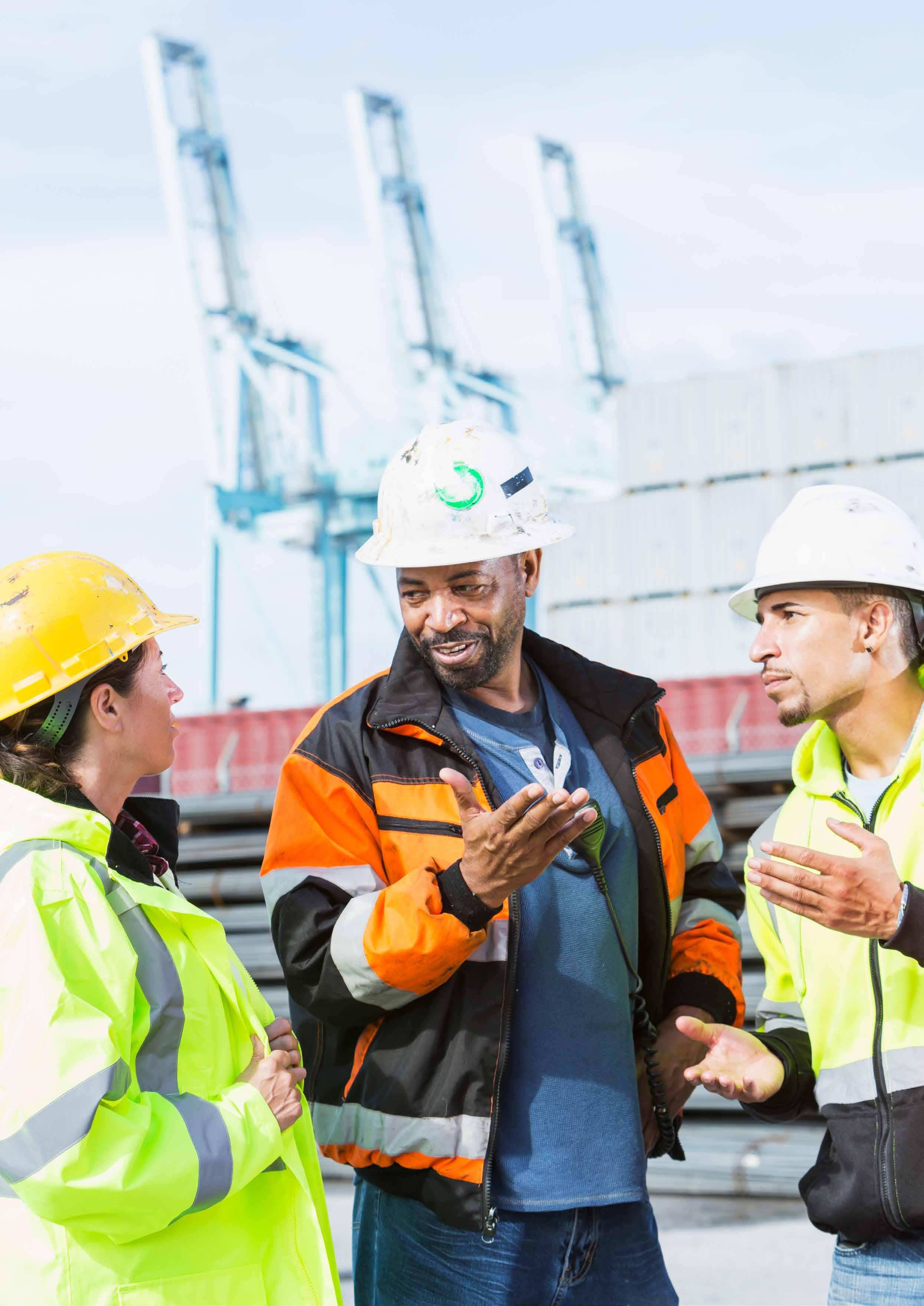


Normagene Dmytriw, Ed. D., Risk Manager, Port Everglades
Ports are essential to global trade and logistics, connecting regions and enabling economic growth. Each port is unique in its geographic location, operational scale, and infrastructure, yet safety remains a universal priority. Managing risks is critical to ensuring smooth operations, whether a port serves cruise passengers, cargo operations, or both. This article explores how safety principles rooted in the model of the port as the landlord can help enhance port operations. It is not a comprehensive list of action items. By addressing leadership, infrastructure, maintenance, risk assessments, and employee involvement, ports can cultivate a safety culture that minimises risks and improves operational efficiency.
A strong safety culture begins with leadership. Senior leaders play a pivotal role in setting the tone for safety within their organisations. Their actions influence how employees perceive and prioritise safety at all levels. Leadership commitment must extend beyond fulfilling regulatory requirements and focus on embedding safety as a core value in the organisational ethos.
The key to fostering a safetyfirst mindset lies in effective communication. Leaders must clearly articulate that safety is not negotiable and emphasise that it is a shared responsibility. Employees must understand that safety is not merely the function of a safety

manager but a collective effort. Open communication channels where workers can report hazards without fear of reprisal further reinforce this culture. By way of example, at Port Everglades we invite employees to report unsafe conditions to the safety committee. The committee then investigates the issue and decides on the appropriate action to address the hazard.
Actions speak louder than words, and trust is built when leaders demonstrate their commitment to safety through visible involvement. Participating in training sessions, conducting site visits, and addressing concerns directly show employees that safety is not just a policy on paper but an integral part of the workplace. Moreover,
senior leaders’ commitment must be consistent to reinforce the importance of safety in the workplace.
Adequate budgeting by senior leadership is another critical aspect. Beyond purchasing Personal Protective Equipment (PPE), budgets should include resources for training, inspections, equipment upgrades, and time allocated for safety practices.
Leaders who actively allocate and utilise these resources underscore safety as a priority. Not to mention the studies that have shown that investing in safety positively impacts the bottom line. For instance, the National Safety Council found that for every dollar invested in safety, businesses can see a return of up to $6.15.
Infrastructure is the backbone of safety at any port. While infrastructure development often prioritises capacity and operational efficiency, its impact on safety cannot be overstated. Ports must invest in designs and improvements that address both current operational needs and future challenges.
One essential design element that can enhance safety is lighting. Poor lighting contributes to slips, trips, and falls—some of the most common workplace injuries. Ports must ensure well-lit environments that adhere to industry standards, covering operational areas such as docks, container yards, and warehouses. Enhanced lighting is particularly important in high-risk zones where precision is essential, such as equipment operation areas or storage zones for hazardous materials. At Port Everglades, we solicit input from
individuals, groups and consultants to make informed budgetary decisions on high-mast lights as part of our holistic approach to safety.
Dockside infrastructure such as berths and fenders also demand attention. These elements ensure the safety of vessels and personnel. Berths must be regularly inspected and maintained to accommodate the size and weight of modern ships. Fenders play a crucial role in absorbing the kinetic energy of docking vessels, preventing damage and reducing risks to workers nearby. Failure to maintain these structures can lead to costly accidents, underscoring the need for proactive investment.
Cranes are another critical infrastructure component that influences safety. To safely operate this complex equipment, multiple safety protocols must be in play, including PPE, inspections, maintenance, and training. In addition, independent and frequent
inspections are best practices whether it is a ship-to-shore crane, a Rubber-Tyred Gantry (RTG) crane, or a mobile crane. Routine maintenance is essential for preventing equipment failures and protecting employees. Training for the operator and individuals in designated work areas is also needed.
Ports must also prepare for natural disasters. Resilient infrastructure safeguards operations and protects employees and visitors during adverse events. Methods to mitigate risks associated with hurricanes, floods, and rising sea levels include elevated designs, reinforced structures, and materials that withstand extreme weather conditions. Port Everglades, for example, is undertaking a $269 million effort to replace ageing bulkheads (or seawalls) throughout the port and along its entrance channel that includes provisions for sea-level rise and climate change over the next 75 years.


Maintenance is often considered a function of operational efficiency, but its impact on safety is just as significant. Preventive maintenance programs allow ports to identify and address potential issues before they escalate into accidents. A comprehensive maintenance strategy includes routine inspections, timely repairs, and replacing outdated equipment. Routine inspections and maintenance of forklifts, aerial lifts, front-end loaders and other heavy equipment allow for the identification of potential hazards, and timely repairs before an accident or injury occurs. For example, at Port Everglades, employees are expected to perform pre-trip inspections in addition to independent third parties performing annual inspections. Ports that neglect properly maintaining their infrastructure and equipment risk exposing workers to
unsafe conditions, compromising safety and productivity.
In order to execute this proactive approach, inspections require trained personnel who can recognise hazards and prioritise corrective actions. Specialised training ensures inspectors can assess infrastructure and equipment effectively, enabling them to identify risks that may not be immediately apparent. When paired with regular maintenance, inspections create a safety net that minimises the likelihood of incidents.
Risk assessments are a cornerstone of any effective safety strategy. They provide a systematic approach to identifying hazards, evaluating their severity, and developing mitigation measures. This process is especially important for ports where risks are multifaceted and often site-specific.
Natural hazards such as hurricanes or earthquakes pose significant threats, particularly for ports in vulnerable regions. Ports must assess these events' probability and potential impact, implementing measures such as flood barriers or elevated construction to reduce vulnerabilities. Human-made risks, including equipment malfunctions and human error, require different solutions. For instance, installing guardrails and providing fallprevention training can make elevated workspaces safer. Modern technology can enhance traditional risk assessment methods. Sensors and monitoring systems provide real-time data on equipment performance, enabling early detection of potential failures. Predictive analytics further refine this approach by identifying patterns and trends that suggest emerging risks. By integrating these tools, ports can proactively address hazards, reducing the likelihood of accidents.
While leadership sets the framework and infrastructure provides the tools, employees drive a port’s safety culture. Employee engagement, training, and participation determine the effectiveness of safety initiatives.
Training is the foundation of employee involvement in safety. Effective programmes go beyond compliance, equipping workers with the skills and knowledge to identify and address hazards. Hands-on training and simulations are particularly valuable, as they provide direct experience with potential risks and their mitigation. Continuous education ensures that employees remain informed about evolving safety practices and standards.
Empowerment is equally important. Employees should feel encouraged to report safety concerns, participate in risk assessments, and suggest improvements. Organisations can reinforce this by establishing anonymous reporting systems and recognising individuals contributing to safety initiatives. When employees see their efforts acknowledged and supported, they are more likely to take ownership of safety practices.
A safety-oriented workforce also benefits from the resources and support provided by leadership. Access to modern equipment,
ongoing training, and a responsive leadership team create an environment where safety is prioritised. This collaboration between employees and leadership fosters continuous improvement, ensuring safety practices evolve alongside operational changes.
The maritime industry constantly evolves, presenting new challenges and opportunities for safety management. Technological advancements like automation offer ways to improve efficiency and reduce human error. However, these innovations also introduce new risks, such as cybersecurity threats and the need for specialised maintenance protocols. Ports must adapt their safety strategies to address these changes, ensuring that technology enhances rather than compromises safety. Climate change is another significant challenge. Rising sea levels, frequent extreme weather events, and shifting environmental conditions require proactive planning. Resilient infrastructure, adaptive operational strategies, and collaboration with industry stakeholders are essential to mitigating these risks. By addressing current and future challenges, ports can ensure their safety strategies remain effective in a rapidly changing world.
Safety is not a static achievement but a continuous effort that requires collaboration and commitment at every level. By focusing on leadership, infrastructure, maintenance, risk assessments, and employee empowerment ports can build a culture where safety is a shared responsibility and a core value. As the maritime industry evolves, these principles will remain essential, enabling ports to adapt to new challenges while maintaining their commitment to safety and operational excellence.
Normagene Dmytriw, Ed. D, has more than 30 years of risk management experience in the private and public sectors. As the Risk Manager at Broward County’s Port Everglades, she leads safety and organisational development, oversees the property damage and personal injury claims process, and drives compliance across multiple regulatory areas.
As one of Florida’s leading economic generators, Port Everglades is a dynamic gateway for international trade and cruise vacations. Consistently ranked among the top three busiest cruise homeports in the world, Port Everglades is also one of the nation’s leading container ports and South Florida’s main seaport for receiving energy products.


Dr Kate Blackford, Founder, Origami
I recently had the pleasure of moderating a panel discussion around Innovation and Technology for Safer Ports: Benefits and Limitations at the Maritime Safety Series Conference. It proved to be a fascinating conversation with one theme recurring throughout the discussion, that of managing the transition to new technology and resistance to such changes.
Technology brings many exciting prospects for improving safety and security in the port industry, but what about the people who need to use the new technology? How do we ensure a smooth transition and safe and correct usage of new technologies? How do we manage any resistance we encounter during the process of change?
It is often these human elements of change that catch organisations out. While technologies are complex, humans offer an infinite range of possible responses, reactions, attitudes and behaviours and whilst we can predict what may happen, we will never be able to know with certainty how our people will react.
There are, however, things we can do to reduce resistance to change, smooth the transition and prepare our people for the inevitable changes that come with the technological age within which we exist. Investment in these aspects of introducing new technologies could make the difference between a seamless transition and a big headache.
Change can be challenging for the best of us and when it is not our choice, resistance is more likely. Resistance is the result of fear. Fear of change itself, of job loss as a

result of new technology, of needing to learn new systems, technologies, ways of working and processes. Fear can create challenges, it can create resistance and it can slow down or even halt the changes an organisation seeks to make.
If we fail to manage change appropriately, not only can we end up with employees who don’t know how to use the new technology safely, but we can erode trust. Now, trust may not seem like it has a lot to do with safety, but it is a critical factor in ensuring we have open communication because, without it, we open ourselves to great risk. When communication is suppressed because our people don’t trust us, we don’t get to know about potential problems and that leaves us vulnerable to harm. We also don’t get to hear about what is working well, or where opportunities to improve our operations might lie. We are unable to learn and this can result
in stagnation or the introduction of ‘improvements’ that don’t actually improve things! This can result in processes becoming overly complex or even increasing risk.
How do we ensure we bring our people along with us as we introduce new technology? We can inform them via email communications, training on the new technology and team conversations, but what about those who resist the changes? What’s that about? And how on earth do we tackle it?
We can forge ahead, introduce the technology and take the “like or lump it” approach. But there are implications to this approach. It negatively impacts motivation, engagement, cooperation and (you guessed it) trust. We can lose experienced members of the team and find ourselves with a staffing shortage and the need to find the time and money to recruit new staff. All problems we don’t need to be dealing with at a busy time of change and problems that don’t need to exist in the first place.
Firstly, take a step back. Are we seeing our people as the problem, or as a part of the solution? If we are seeing them as the (potential) problem, we have a problem! Yes, it can be frustrating when we want to get that new technology up and running, but we do need to bring our people with us on the journey. They need to feel engaged in the changes, involved in the process and they need to understand the implications. This is how we engender trust.
As leaders, we need to understand the human impact of change, resistance to change and how to get ahead of it so we reduce (or even remove) it before it has the chance to take root. It’s a lot harder to backpedal and regain trust once the resistance has taken hold than it is to prevent it in the first place.
In order to do this we must first understand some of the fundamentals of the human condition. Specifically, the nature of fear, how it impacts us and how to reduce the likelihood of triggering the fear response in the first place. Achieving this is about more than an email communication about what’s going to happen, or a training course about how to use the new technology.
So what is fear? Fear is a biological and neurological response to a perceived threat. That threat can be real or imagined. It can be physical, psychological or social in nature. For example, fear of losing our job due to the introduction of new technology might trigger a perception of physical threat: “How will I pay the bills and keep the roof over my family’s head?”. It may create a perception of psychological threat
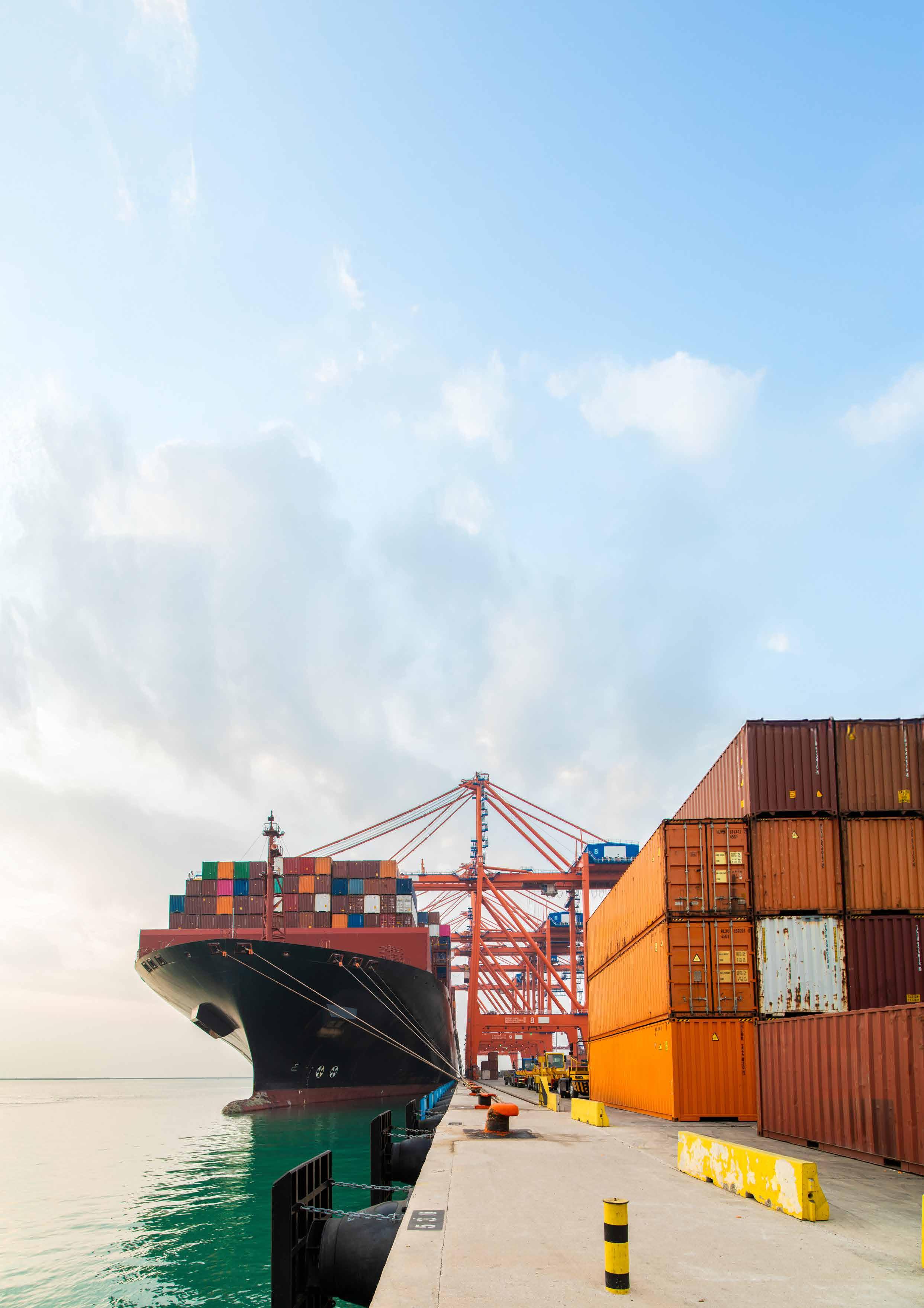
in the form of the potential mental health impact of losing our job. Or it could present a perceived social threat in terms of a perception of loss of status due to job loss.
The important thing to recognise is that it is the perception of threat, as well as the reality of it that can trigger the fear response. Just because the thing we fear hasn’t happened yet and may never happen, doesn’t make it any less frightening and it doesn’t make the response any less unpleasant or intense for the person experiencing it.
The fear response is hardwired into all of us. It is a natural and essential mechanism designed at the most basic level to keep us alive. The brain doesn’t differentiate between physical, psychological or social threats, so the fear response is the same.
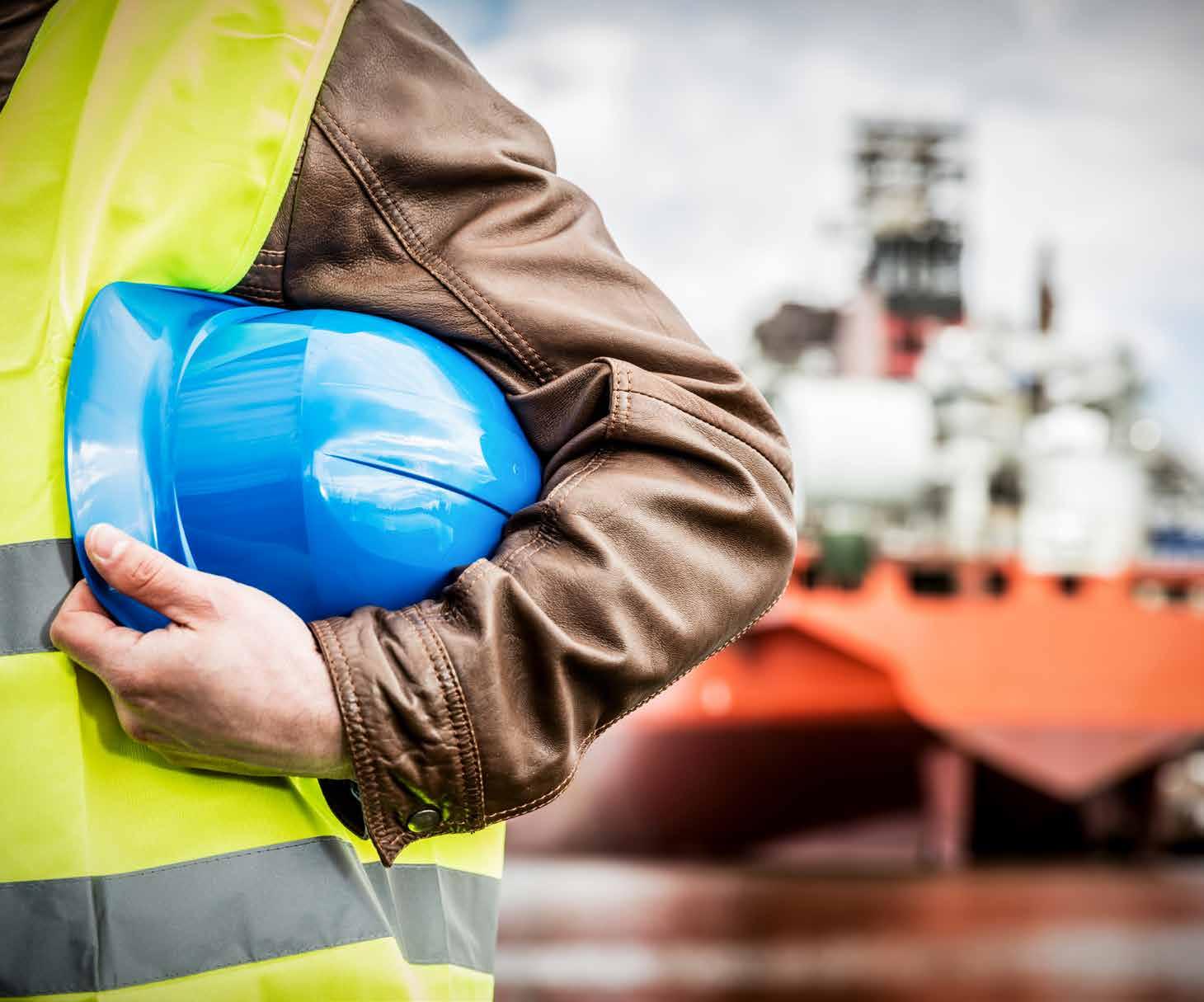
When fear strikes, the amygdala triggers the sympathetic nervous system, releasing adrenaline and cortisol. These chemicals raise blood pressure, heart rate, and breathing while redirecting blood from organs to limbs, priming us for fight or flight. Simultaneously, blood flow to the brain’s logic centre decreases, hindering rational decision-making but ideal for immediate action against physical threats.
However, most modern threats are psychological or social, where clear thinking would help. Yet, the brain reacts the same to all threats. This explains why someone in a state of irrational fear struggles to grasp reassurance, as their brain treats the threat as real.
The safe and successful management of change around the introduction of new technology (or any change) requires understanding some of the fundamental aspects
of being human. When we can understand and empathise with the driver for resistance, we can work with people to reassure them and make the process of change as comfortable as possible. By doing so we preserve (and when done well even enhance) trust and by extension, safety.
Achieving this successfully requires that we as leaders develop a deeper understanding of the human condition such that we are able to better understand and support our colleagues and teams at all times, not just in the face of change.
As such great (safety) leadership becomes about so much more than telling people what to do and when, following that new communication model we learned or delivering inspiring speeches at the annual conference.
It is about who we are as people and how that reflects in how we lead. It is about understanding some of the mechanisms of how we work as human beings—what motivates us, dis-engages us,
engenders trust and enhances or reduces the likelihood of us perceiving risk. It requires understanding what encourages and enhances communication, learning and growth both for the individuals and the organisation. After all, an organisation is no more, or less, than the sum of its people.
In short, it requires that we look at safety culture and leadership differently. It requires a deeper dive into who we are as individuals and how that reflects in our leadership. It requires that we be willing to constructively challenge ourselves and each other, our perspectives, and our perceptions of why people do what they do so that we can improve as human beings and as leaders. Ultimately, it is generally not the leadership of an organisation using the new technology, but we as leaders set the tone for how it is received and utilised by those that do. As such, we must lead courageously and challenge ourselves consistently to fulfil the duty of care to our people, customers, and community, whether in the face of change or not.
With almost 20 years of experience working with heavy industry, Kate brings a unique perspective to improving organisational safety, health and wellbeing. Her diverse experience and training in Organisational Psychology, NeuroLinguistic Programming, Coaching and Therapy have enabled Kate to develop innovative solutions to the human challenges faced by all organisations.
Founded by Dr Kate Blackford in 2019 Origami creates effective, highimpact solutions to organisational challenges around safety, health and wellbeing. Offering a suite of services, including leadership training and coaching, wellbeing webinars, organisational culture assessments, bespoke organisational improvement programmes and more, Origami helps organisations thrive.


Richard Steele, CEO, ICHCA
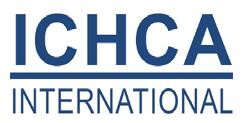
This article was informed by contributions from Neil Dalus, Normagene Dmytriw, and George Wagner.
Collaboration and communication with professional peers are more essential than ever for the entire cargo supply chain. Sharing industry expertise allows us to learn, innovate, and drive meaningful change.
As CEO of the International Cargo Handling Coordination Association (ICHCA), I have the privilege of learning daily from safety and organisational leaders from around the globe. What is clear from that experience is that influencing others is at the heart of what they do. The safety of their people and delivery of their responsibility is contingent on effectively communicating with others and supporting them to play their roles well, to create workplace environments where people will make good health and safety decisions, where they trust and are trusted, and where everyone is a safety champion.
Ultimately, good safety leadership is really just good leadership; the same core skills apply. Similarly, an organisation’s safety culture is really just the organisation’s culture. All organisational trust and empowerment benefits safety and all safety trust and empowerment benefits an organisation.
The role of safety leadership has moved far beyond ‘process’. Checking if workplace protective equipment is being correctly worn is important, for example, but it is a small part of an overall humancentric safety strategy. Approaches should be about advocacy, empowerment, and creating sustainable change through action and thought leadership.

So, what does that mean in practical terms at the quayside for ports and terminals? Speaking to colleagues in recent months, it remains clear that the industry has the knowledge and understands the goals, the difficult and messy part is turning them into reality. The genius is in creating a workplace reality that matches the vision— ensuring that work as done on the ground is consistent with work as imagined at the top of an organisation. Health and safety will never be ‘job and done’. It is a process of continuous learning and change. Although there is no single guaranteed approach, I think that real-world examples are well worth sharing.
Start from where you are. Make time to understand the real health and safety picture. Whenever practicable, make sure to have a strategy for both lagging and leading indicators. One of our members has had a measurable reduction in lost
time injury frequency by focusing on good safety performance. They made sure that they were capturing all—not just selective or special case—incidents and then aimed to cut them in half through shared ownership and homegrown lifesaving rules that fit the organisation. Managers use regular workplace visits to understand risks, supervisors can intervene on unsafe acts or omissions and workers can look out for each other, intervening with their friends to keep them safe. Ownership is built through supervisors and managers doing the training and monitoring. This makes them better at spotting safety risks and taking action to address them. The focus is on growing a shared culture, not on catching people out. This operator achieved their initial target of a 50 per cent reduction in lost time injury frequency rate in a three-year period.
Another port operator focused on how senior leadership could set the tone for a healthy safety culture. They worked on several
key traits: leading by example— being seen to follow safety rules; sending a firm message that safety is not negotiable; establishing clear expectations that safety is everyone’s responsibility; and providing time and resources for and participating in safety training at all levels. Additionally, they emphasised listening to and acting on safety concerns as well as budgeting for safety and infrastructure.
As a landlord port they considered how their infrastructure could positively affect employee and visitor safety. Slips, trips and falls are one of the most frequently cited presenting causes of incidents in ports. This operator minimised uneven surfaces and put effort into effectively lighting berths, yards and terminals. They also concluded that their maintenance and routine inspections could impact proactively safety culture by visibly identifying and addressing potential hazards and preventing accidents that could be caused by malfunction or failure. They used their maintenance planning not only to help determine when things need to be repaired or replaced but also to help identify when something needs to be changed altogether. Routine berth
and fender inspections are used to help evaluate if the current provision can continue to handle evolving ship sizes, velocities and navigation conditions. They also directly addressed warehouse ventilation and handling equipment exhaust/environment management and established contractual requirements for equipment training.
Thinking further about training, one colleague visits many ports around the world each year for loss prevention work. This crossing of geographic, organisational and regulatory framework boundaries provides valuable insight into ports and terminals, and what they do similarly and differently. In a very tangible way, he notes the importance of the induction process for driving a safety culture with both employees and visitors. Induction is a swift litmus test for what safety culture is like at a port. Induction or onboarding is the ‘first chance’ you get to set the scene of what is expected of both employees and visitors to a site. The environment and the expectations that leaders create for their sites play a significant part in how people act.
Ports and terminals may be individually different but most cargo operation risks are universal. ICHCA’s data shows that globally, since 2000, the top four most likely causes of severe human consequence incidents are crushed by moving cargo, vehicles striking pedestrians, confined spaces and falls.
Layered in with these severe risks is the need to manage higher frequency, lower consequence challenges such as slips, trips and falls, strains, sprains, lacerations, bruising and pinches. Added to those are prevention of long-term health impacts (e.g. muscularskeletal and respiratory risks) all rounded out with addressing mental health and wellbeing challenges.
With such a complex challenge our industry must continue to look beyond siloed thinking. First, by sharing good practice. The examples that I mentioned above are just a few of the many out there and are eminently repeatable elsewhere. Importantly, at least one of these approaches came from experience in a different industry. If it is genuinely good practice, it is

likely to be universal.
Second, by sharing insight when something goes wrong, ensuring that lessons are learned once, learned fast and stay learned.
Third, by sharing innovation. New technology plays a key role, providing inspiration, insights, and new ways of doing old tasks. For example, eliminating risks like falling from a height should be the first option. The use of drones to inspect elevated structures can reduce the need for people to climb cranes or gantries, new designs of lighting pylons are available where the lights can be lowered to the ground for maintenance avoiding the need to climb or use other work-at-height equipment. More comfortable and effective fall arrest systems can encourage consistent usage, while digital systems can improve tracking and regulatory compliance, and minimise fatigue. However, technology is never introduced in a vacuum. For innovation to stand a chance of success, it has to work, it must not create new worse or uncontrollable risks and critically, it must place the human experience at the centre. Collaboration, cooperation and communication with the people who will use the innovation will make the difference between success and failure.
Safety culture is extraordinarily vulnerable any time that people believe (fairly or unfairly) that there is a gap between what the organisation says its values are and what values are actually experienced on the ground. Such damage can be long-lasting. If safety is declared the number one priority, then it must be reflected in actions.
It is no coincidence that accidents can often be traced back to gaps between procedures and actual work practices. Aligning work as imagined and work as done can reduce the risk of accidents, while the connection between the stated values and the values experienced strengthens safety culture. In turn, a strong safety culture can reduce accidents, and risk reduction can improve safety culture. Building a desired safety culture is a marathon, not a sprint. To avoid going stale, it requires continuous energy input into the system in evolving and novel ways. The ones that succeed do so because leaders ‘walk the talk’ and establish meaningful involvement with employees at all levels. Every step forward is hard-won but worth it.
In a very particular way, safety
leadership is about taking risks. Positive change often comes from doing the things that are not easy; stretching the ‘art of the possible’ as far as it will go.
Richard Steele is Chief Executive Officer at the International Cargo Handling and Coordination Association – ICHCA. Reporting directly to the Board, Richard leads the organisation which provides a focal point to improve cargo handling health and safety throughout international supply chains. ICHCA also represents members, and the cargo handling industry, as a recognised nongovernment organisation at international bodies such as the International Maritime Organisation and UNECE and other agencies and regulatory bodies.
Established in 1952, ICHCA International is an independent, not-for-profit organisation dedicated to improving the safety, productivity and efficiency of cargo handling and movement worldwide. ICHCA’s privileged NGO status enables it to represent its members, and the cargo handling industry at large, in front of national and international agencies and regulatory bodies, while its Technical Panel provides best practice advice and develops publications on a wide range of practical cargo handling issues. Operating through a series of national and regional chapters, including ICHCA Australia, ICHCA Japan and plus Correspondence and Working Groups, ICHCA provides a focal point for informing, educating, lobbying and networking to improve knowledge and best practice across the cargo handling chain.
www.ichca.com